Vodafone Business Strategy Report
VerifiedAdded on 2020/12/09
|19
|5413
|345
Report
AI Summary
This report analyzes Vodafone's business strategy using various frameworks like PESTLE, VRIO, Porter's Five Forces, and Ansoff's growth matrix. It examines the impact of macro-environmental factors, analyzes Vodafone's strategic capabilities, evaluates competitive forces, and proposes a strategic management plan for future growth and success.
Contribute Materials
Your contribution can guide someone’s learning journey. Share your
documents today.
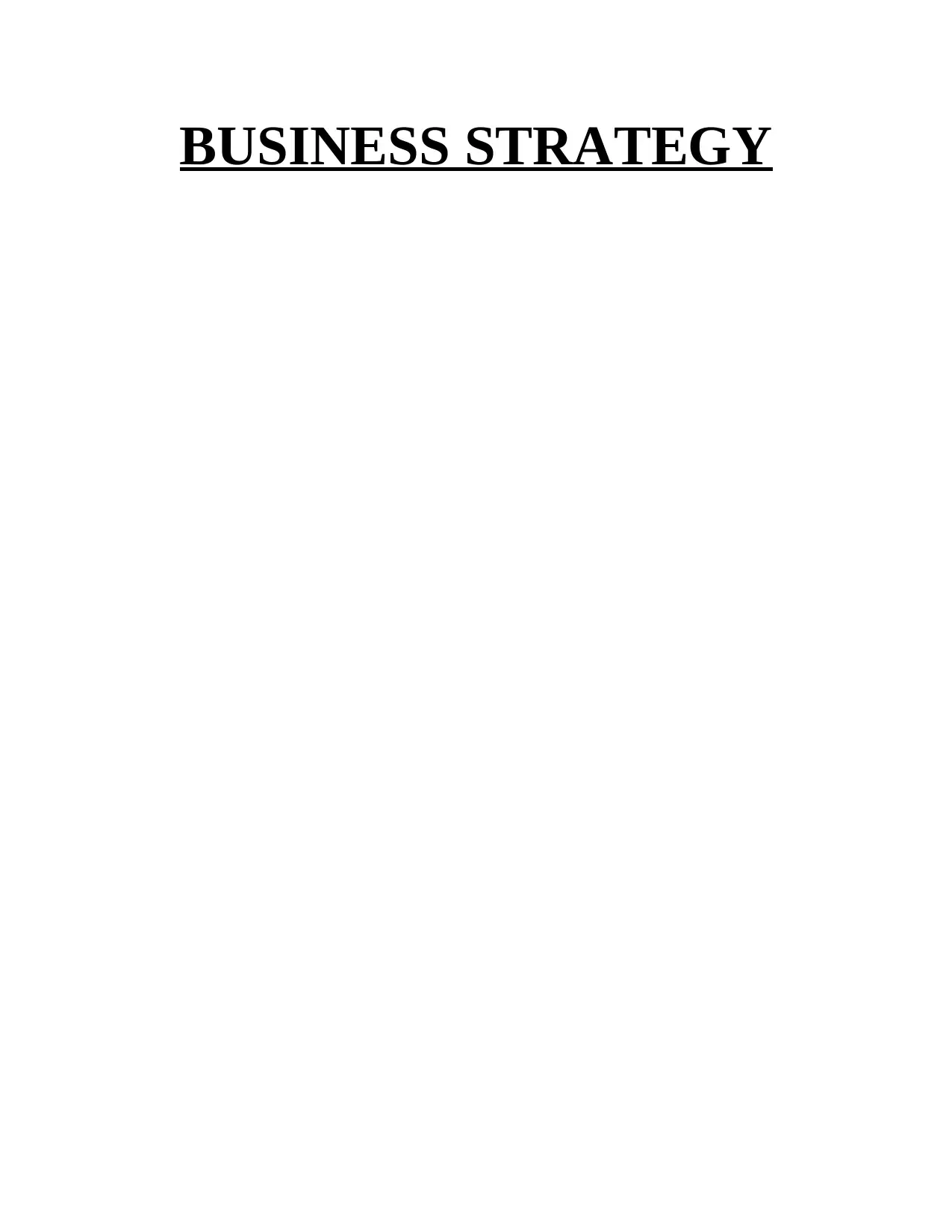
BUSINESS STRATEGY
Secure Best Marks with AI Grader
Need help grading? Try our AI Grader for instant feedback on your assignments.
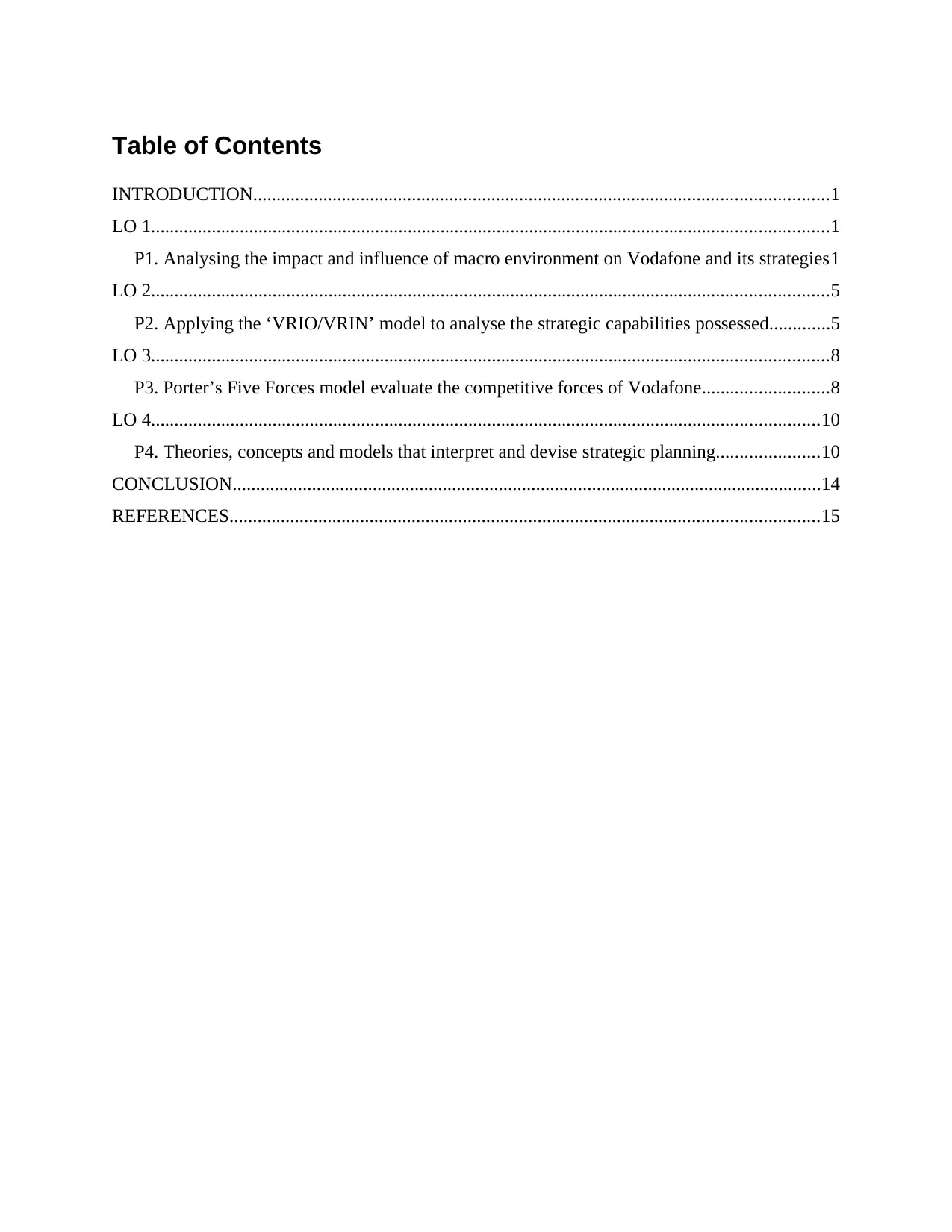
Table of Contents
INTRODUCTION...........................................................................................................................1
LO 1.................................................................................................................................................1
P1. Analysing the impact and influence of macro environment on Vodafone and its strategies1
LO 2.................................................................................................................................................5
P2. Applying the ‘VRIO/VRIN’ model to analyse the strategic capabilities possessed.............5
LO 3.................................................................................................................................................8
P3. Porter’s Five Forces model evaluate the competitive forces of Vodafone...........................8
LO 4...............................................................................................................................................10
P4. Theories, concepts and models that interpret and devise strategic planning......................10
CONCLUSION..............................................................................................................................14
REFERENCES..............................................................................................................................15
INTRODUCTION...........................................................................................................................1
LO 1.................................................................................................................................................1
P1. Analysing the impact and influence of macro environment on Vodafone and its strategies1
LO 2.................................................................................................................................................5
P2. Applying the ‘VRIO/VRIN’ model to analyse the strategic capabilities possessed.............5
LO 3.................................................................................................................................................8
P3. Porter’s Five Forces model evaluate the competitive forces of Vodafone...........................8
LO 4...............................................................................................................................................10
P4. Theories, concepts and models that interpret and devise strategic planning......................10
CONCLUSION..............................................................................................................................14
REFERENCES..............................................................................................................................15
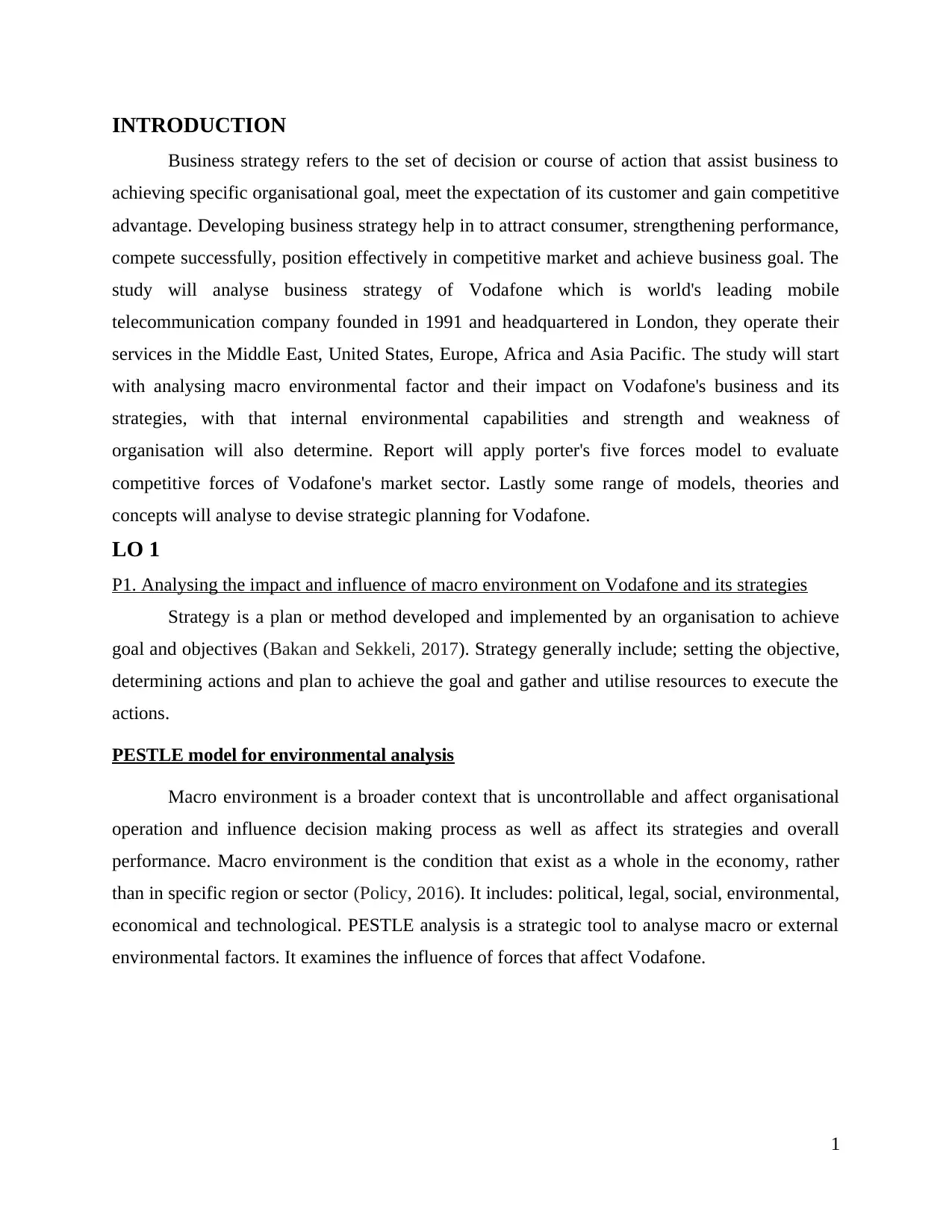
INTRODUCTION
Business strategy refers to the set of decision or course of action that assist business to
achieving specific organisational goal, meet the expectation of its customer and gain competitive
advantage. Developing business strategy help in to attract consumer, strengthening performance,
compete successfully, position effectively in competitive market and achieve business goal. The
study will analyse business strategy of Vodafone which is world's leading mobile
telecommunication company founded in 1991 and headquartered in London, they operate their
services in the Middle East, United States, Europe, Africa and Asia Pacific. The study will start
with analysing macro environmental factor and their impact on Vodafone's business and its
strategies, with that internal environmental capabilities and strength and weakness of
organisation will also determine. Report will apply porter's five forces model to evaluate
competitive forces of Vodafone's market sector. Lastly some range of models, theories and
concepts will analyse to devise strategic planning for Vodafone.
LO 1
P1. Analysing the impact and influence of macro environment on Vodafone and its strategies
Strategy is a plan or method developed and implemented by an organisation to achieve
goal and objectives (Bakan and Sekkeli, 2017). Strategy generally include; setting the objective,
determining actions and plan to achieve the goal and gather and utilise resources to execute the
actions.
PESTLE model for environmental analysis
Macro environment is a broader context that is uncontrollable and affect organisational
operation and influence decision making process as well as affect its strategies and overall
performance. Macro environment is the condition that exist as a whole in the economy, rather
than in specific region or sector (Policy, 2016). It includes: political, legal, social, environmental,
economical and technological. PESTLE analysis is a strategic tool to analyse macro or external
environmental factors. It examines the influence of forces that affect Vodafone.
1
Business strategy refers to the set of decision or course of action that assist business to
achieving specific organisational goal, meet the expectation of its customer and gain competitive
advantage. Developing business strategy help in to attract consumer, strengthening performance,
compete successfully, position effectively in competitive market and achieve business goal. The
study will analyse business strategy of Vodafone which is world's leading mobile
telecommunication company founded in 1991 and headquartered in London, they operate their
services in the Middle East, United States, Europe, Africa and Asia Pacific. The study will start
with analysing macro environmental factor and their impact on Vodafone's business and its
strategies, with that internal environmental capabilities and strength and weakness of
organisation will also determine. Report will apply porter's five forces model to evaluate
competitive forces of Vodafone's market sector. Lastly some range of models, theories and
concepts will analyse to devise strategic planning for Vodafone.
LO 1
P1. Analysing the impact and influence of macro environment on Vodafone and its strategies
Strategy is a plan or method developed and implemented by an organisation to achieve
goal and objectives (Bakan and Sekkeli, 2017). Strategy generally include; setting the objective,
determining actions and plan to achieve the goal and gather and utilise resources to execute the
actions.
PESTLE model for environmental analysis
Macro environment is a broader context that is uncontrollable and affect organisational
operation and influence decision making process as well as affect its strategies and overall
performance. Macro environment is the condition that exist as a whole in the economy, rather
than in specific region or sector (Policy, 2016). It includes: political, legal, social, environmental,
economical and technological. PESTLE analysis is a strategic tool to analyse macro or external
environmental factors. It examines the influence of forces that affect Vodafone.
1
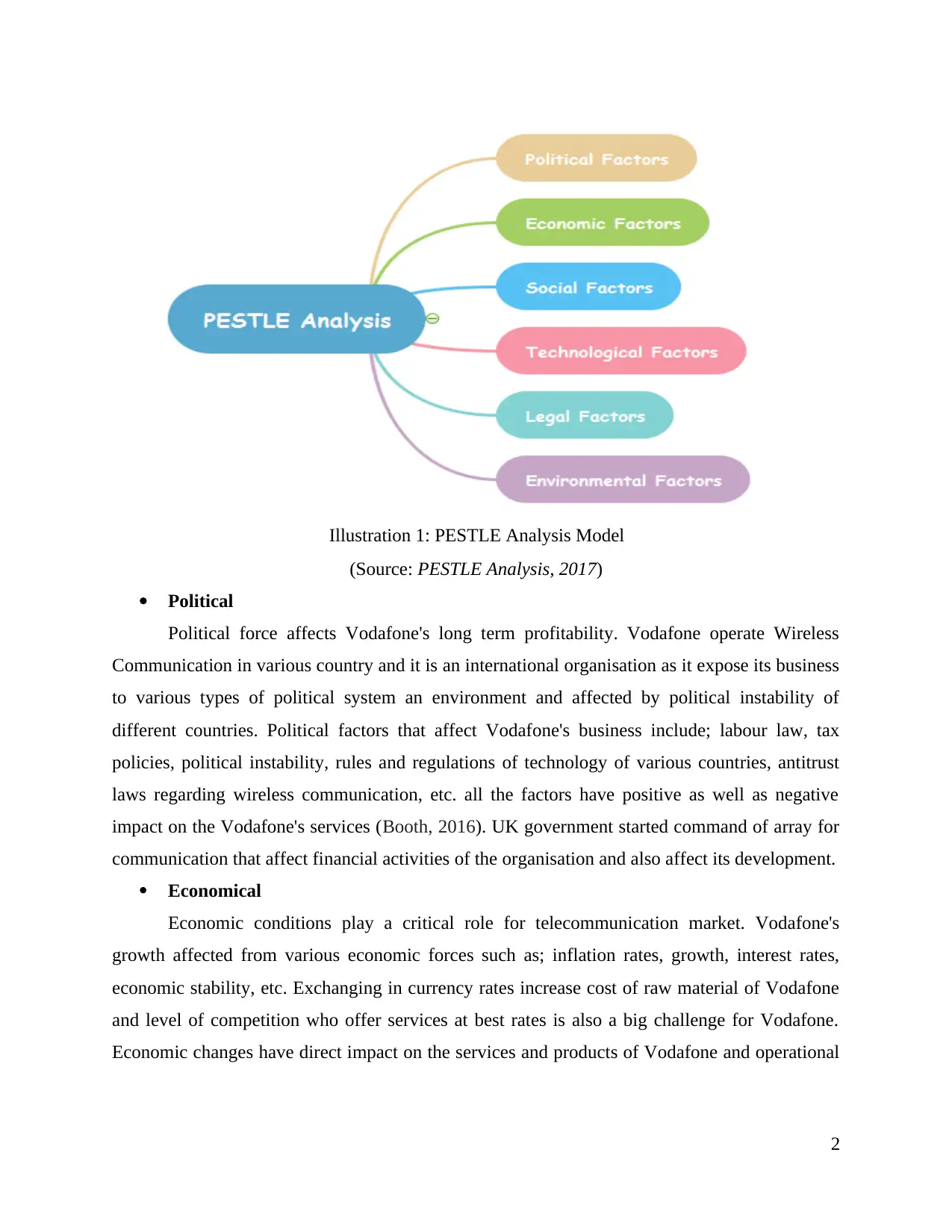
(Source: PESTLE Analysis, 2017)
Political
Political force affects Vodafone's long term profitability. Vodafone operate Wireless
Communication in various country and it is an international organisation as it expose its business
to various types of political system an environment and affected by political instability of
different countries. Political factors that affect Vodafone's business include; labour law, tax
policies, political instability, rules and regulations of technology of various countries, antitrust
laws regarding wireless communication, etc. all the factors have positive as well as negative
impact on the Vodafone's services (Booth, 2016). UK government started command of array for
communication that affect financial activities of the organisation and also affect its development.
Economical
Economic conditions play a critical role for telecommunication market. Vodafone's
growth affected from various economic forces such as; inflation rates, growth, interest rates,
economic stability, etc. Exchanging in currency rates increase cost of raw material of Vodafone
and level of competition who offer services at best rates is also a big challenge for Vodafone.
Economic changes have direct impact on the services and products of Vodafone and operational
2
Illustration 1: PESTLE Analysis Model
Political
Political force affects Vodafone's long term profitability. Vodafone operate Wireless
Communication in various country and it is an international organisation as it expose its business
to various types of political system an environment and affected by political instability of
different countries. Political factors that affect Vodafone's business include; labour law, tax
policies, political instability, rules and regulations of technology of various countries, antitrust
laws regarding wireless communication, etc. all the factors have positive as well as negative
impact on the Vodafone's services (Booth, 2016). UK government started command of array for
communication that affect financial activities of the organisation and also affect its development.
Economical
Economic conditions play a critical role for telecommunication market. Vodafone's
growth affected from various economic forces such as; inflation rates, growth, interest rates,
economic stability, etc. Exchanging in currency rates increase cost of raw material of Vodafone
and level of competition who offer services at best rates is also a big challenge for Vodafone.
Economic changes have direct impact on the services and products of Vodafone and operational
2
Illustration 1: PESTLE Analysis Model
Secure Best Marks with AI Grader
Need help grading? Try our AI Grader for instant feedback on your assignments.
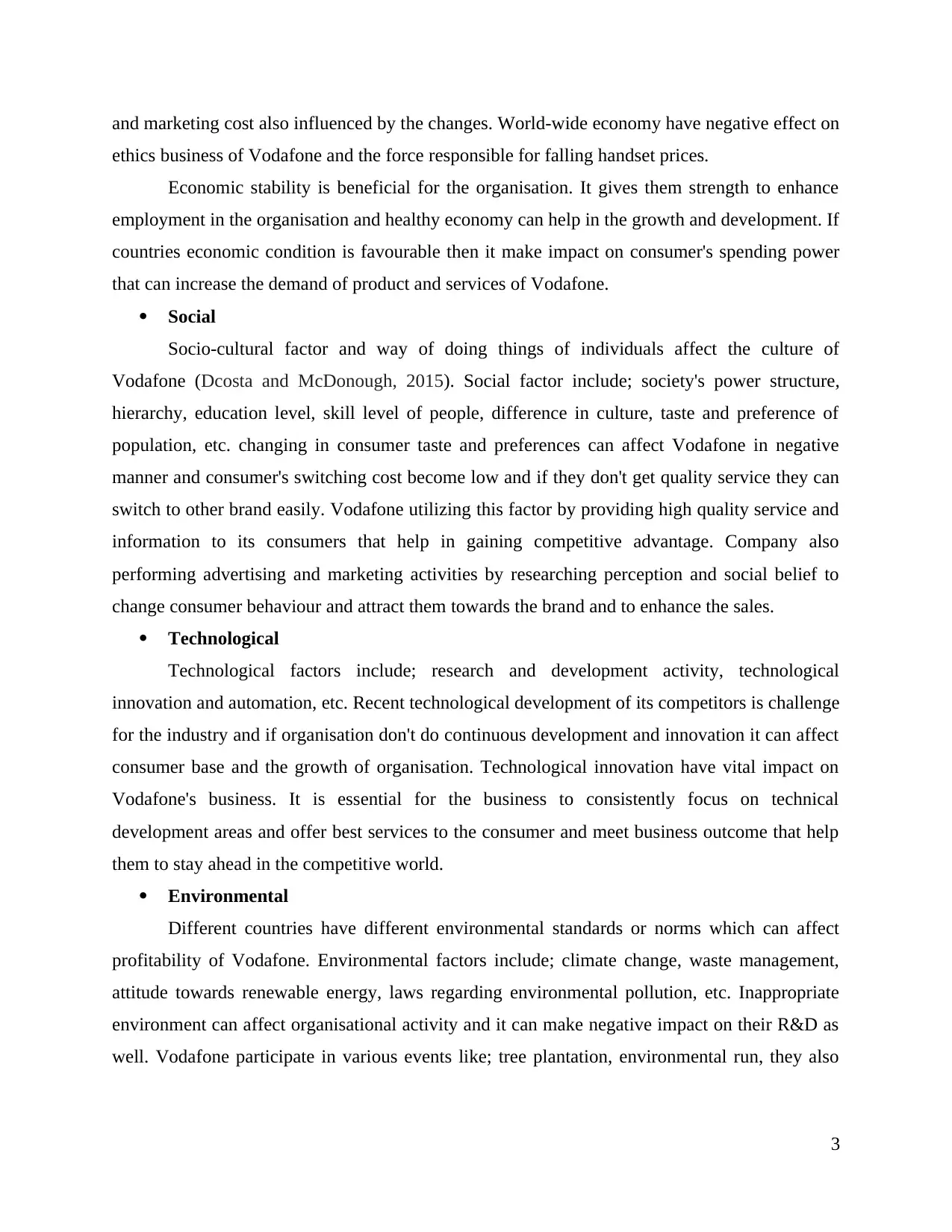
and marketing cost also influenced by the changes. World-wide economy have negative effect on
ethics business of Vodafone and the force responsible for falling handset prices.
Economic stability is beneficial for the organisation. It gives them strength to enhance
employment in the organisation and healthy economy can help in the growth and development. If
countries economic condition is favourable then it make impact on consumer's spending power
that can increase the demand of product and services of Vodafone.
Social
Socio-cultural factor and way of doing things of individuals affect the culture of
Vodafone (Dcosta and McDonough, 2015). Social factor include; society's power structure,
hierarchy, education level, skill level of people, difference in culture, taste and preference of
population, etc. changing in consumer taste and preferences can affect Vodafone in negative
manner and consumer's switching cost become low and if they don't get quality service they can
switch to other brand easily. Vodafone utilizing this factor by providing high quality service and
information to its consumers that help in gaining competitive advantage. Company also
performing advertising and marketing activities by researching perception and social belief to
change consumer behaviour and attract them towards the brand and to enhance the sales.
Technological
Technological factors include; research and development activity, technological
innovation and automation, etc. Recent technological development of its competitors is challenge
for the industry and if organisation don't do continuous development and innovation it can affect
consumer base and the growth of organisation. Technological innovation have vital impact on
Vodafone's business. It is essential for the business to consistently focus on technical
development areas and offer best services to the consumer and meet business outcome that help
them to stay ahead in the competitive world.
Environmental
Different countries have different environmental standards or norms which can affect
profitability of Vodafone. Environmental factors include; climate change, waste management,
attitude towards renewable energy, laws regarding environmental pollution, etc. Inappropriate
environment can affect organisational activity and it can make negative impact on their R&D as
well. Vodafone participate in various events like; tree plantation, environmental run, they also
3
ethics business of Vodafone and the force responsible for falling handset prices.
Economic stability is beneficial for the organisation. It gives them strength to enhance
employment in the organisation and healthy economy can help in the growth and development. If
countries economic condition is favourable then it make impact on consumer's spending power
that can increase the demand of product and services of Vodafone.
Social
Socio-cultural factor and way of doing things of individuals affect the culture of
Vodafone (Dcosta and McDonough, 2015). Social factor include; society's power structure,
hierarchy, education level, skill level of people, difference in culture, taste and preference of
population, etc. changing in consumer taste and preferences can affect Vodafone in negative
manner and consumer's switching cost become low and if they don't get quality service they can
switch to other brand easily. Vodafone utilizing this factor by providing high quality service and
information to its consumers that help in gaining competitive advantage. Company also
performing advertising and marketing activities by researching perception and social belief to
change consumer behaviour and attract them towards the brand and to enhance the sales.
Technological
Technological factors include; research and development activity, technological
innovation and automation, etc. Recent technological development of its competitors is challenge
for the industry and if organisation don't do continuous development and innovation it can affect
consumer base and the growth of organisation. Technological innovation have vital impact on
Vodafone's business. It is essential for the business to consistently focus on technical
development areas and offer best services to the consumer and meet business outcome that help
them to stay ahead in the competitive world.
Environmental
Different countries have different environmental standards or norms which can affect
profitability of Vodafone. Environmental factors include; climate change, waste management,
attitude towards renewable energy, laws regarding environmental pollution, etc. Inappropriate
environment can affect organisational activity and it can make negative impact on their R&D as
well. Vodafone participate in various events like; tree plantation, environmental run, they also
3
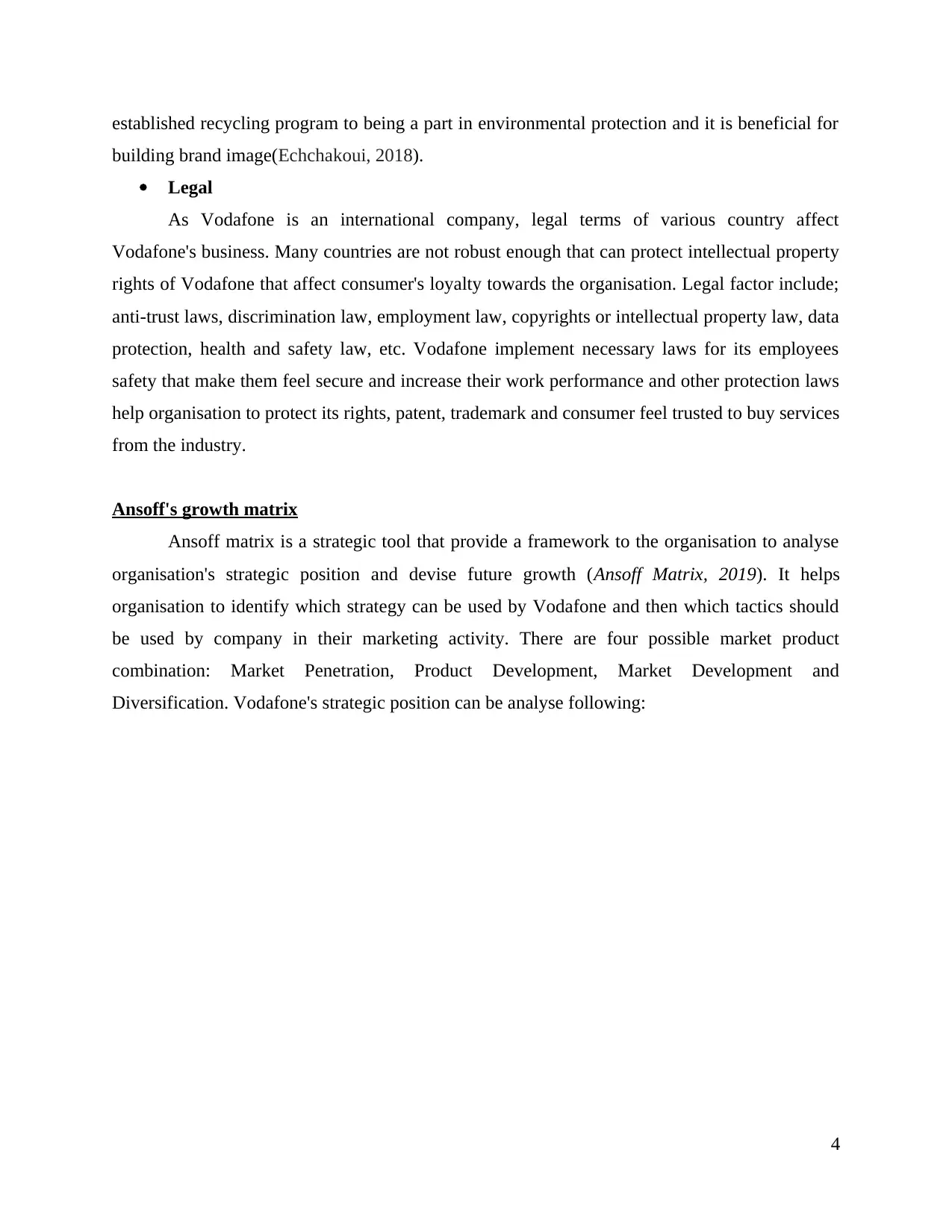
established recycling program to being a part in environmental protection and it is beneficial for
building brand image(Echchakoui, 2018).
Legal
As Vodafone is an international company, legal terms of various country affect
Vodafone's business. Many countries are not robust enough that can protect intellectual property
rights of Vodafone that affect consumer's loyalty towards the organisation. Legal factor include;
anti-trust laws, discrimination law, employment law, copyrights or intellectual property law, data
protection, health and safety law, etc. Vodafone implement necessary laws for its employees
safety that make them feel secure and increase their work performance and other protection laws
help organisation to protect its rights, patent, trademark and consumer feel trusted to buy services
from the industry.
Ansoff's growth matrix
Ansoff matrix is a strategic tool that provide a framework to the organisation to analyse
organisation's strategic position and devise future growth (Ansoff Matrix, 2019). It helps
organisation to identify which strategy can be used by Vodafone and then which tactics should
be used by company in their marketing activity. There are four possible market product
combination: Market Penetration, Product Development, Market Development and
Diversification. Vodafone's strategic position can be analyse following:
4
building brand image(Echchakoui, 2018).
Legal
As Vodafone is an international company, legal terms of various country affect
Vodafone's business. Many countries are not robust enough that can protect intellectual property
rights of Vodafone that affect consumer's loyalty towards the organisation. Legal factor include;
anti-trust laws, discrimination law, employment law, copyrights or intellectual property law, data
protection, health and safety law, etc. Vodafone implement necessary laws for its employees
safety that make them feel secure and increase their work performance and other protection laws
help organisation to protect its rights, patent, trademark and consumer feel trusted to buy services
from the industry.
Ansoff's growth matrix
Ansoff matrix is a strategic tool that provide a framework to the organisation to analyse
organisation's strategic position and devise future growth (Ansoff Matrix, 2019). It helps
organisation to identify which strategy can be used by Vodafone and then which tactics should
be used by company in their marketing activity. There are four possible market product
combination: Market Penetration, Product Development, Market Development and
Diversification. Vodafone's strategic position can be analyse following:
4
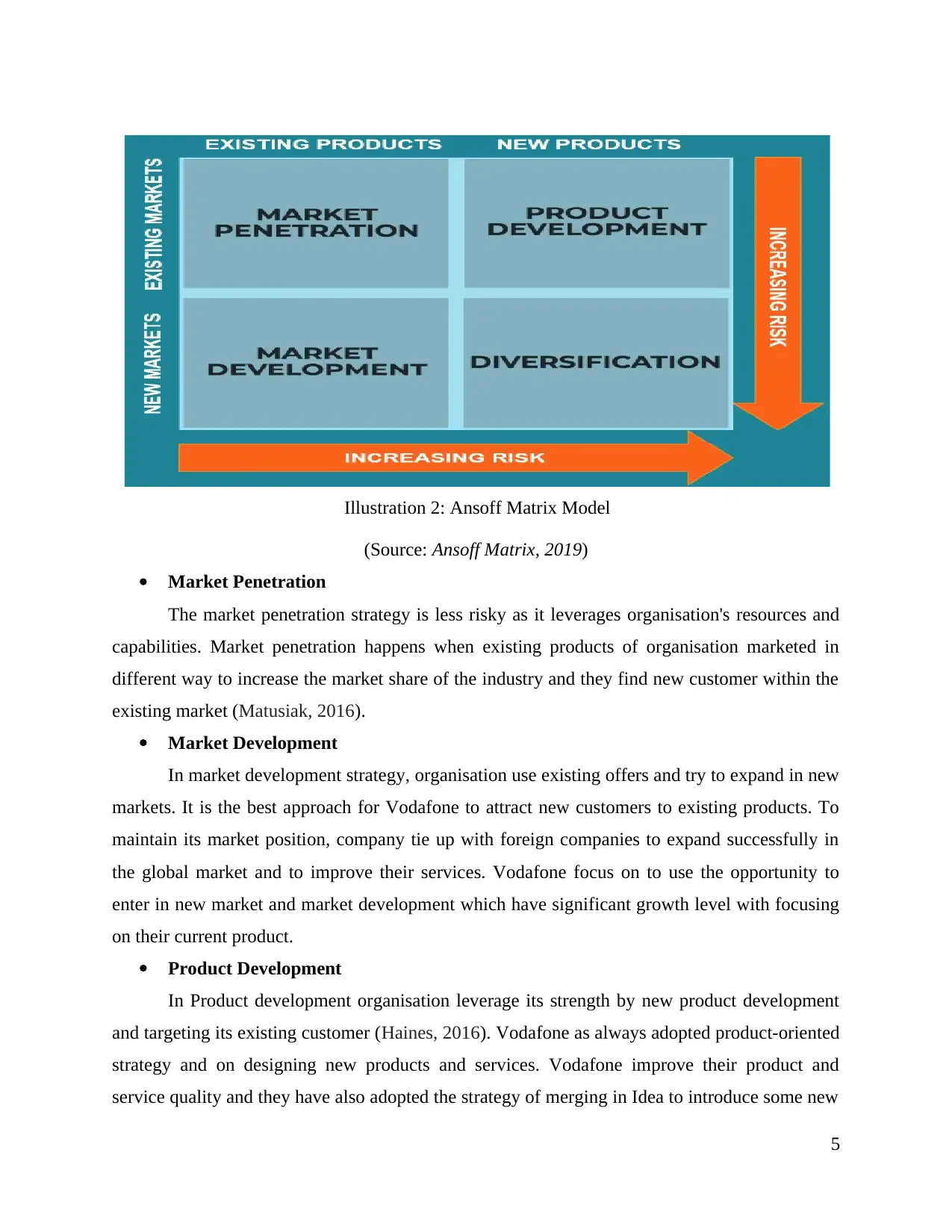
(Source: Ansoff Matrix, 2019)
Market Penetration
The market penetration strategy is less risky as it leverages organisation's resources and
capabilities. Market penetration happens when existing products of organisation marketed in
different way to increase the market share of the industry and they find new customer within the
existing market (Matusiak, 2016).
Market Development
In market development strategy, organisation use existing offers and try to expand in new
markets. It is the best approach for Vodafone to attract new customers to existing products. To
maintain its market position, company tie up with foreign companies to expand successfully in
the global market and to improve their services. Vodafone focus on to use the opportunity to
enter in new market and market development which have significant growth level with focusing
on their current product.
Product Development
In Product development organisation leverage its strength by new product development
and targeting its existing customer (Haines, 2016). Vodafone as always adopted product-oriented
strategy and on designing new products and services. Vodafone improve their product and
service quality and they have also adopted the strategy of merging in Idea to introduce some new
5
Illustration 2: Ansoff Matrix Model
Market Penetration
The market penetration strategy is less risky as it leverages organisation's resources and
capabilities. Market penetration happens when existing products of organisation marketed in
different way to increase the market share of the industry and they find new customer within the
existing market (Matusiak, 2016).
Market Development
In market development strategy, organisation use existing offers and try to expand in new
markets. It is the best approach for Vodafone to attract new customers to existing products. To
maintain its market position, company tie up with foreign companies to expand successfully in
the global market and to improve their services. Vodafone focus on to use the opportunity to
enter in new market and market development which have significant growth level with focusing
on their current product.
Product Development
In Product development organisation leverage its strength by new product development
and targeting its existing customer (Haines, 2016). Vodafone as always adopted product-oriented
strategy and on designing new products and services. Vodafone improve their product and
service quality and they have also adopted the strategy of merging in Idea to introduce some new
5
Illustration 2: Ansoff Matrix Model
Paraphrase This Document
Need a fresh take? Get an instant paraphrase of this document with our AI Paraphraser
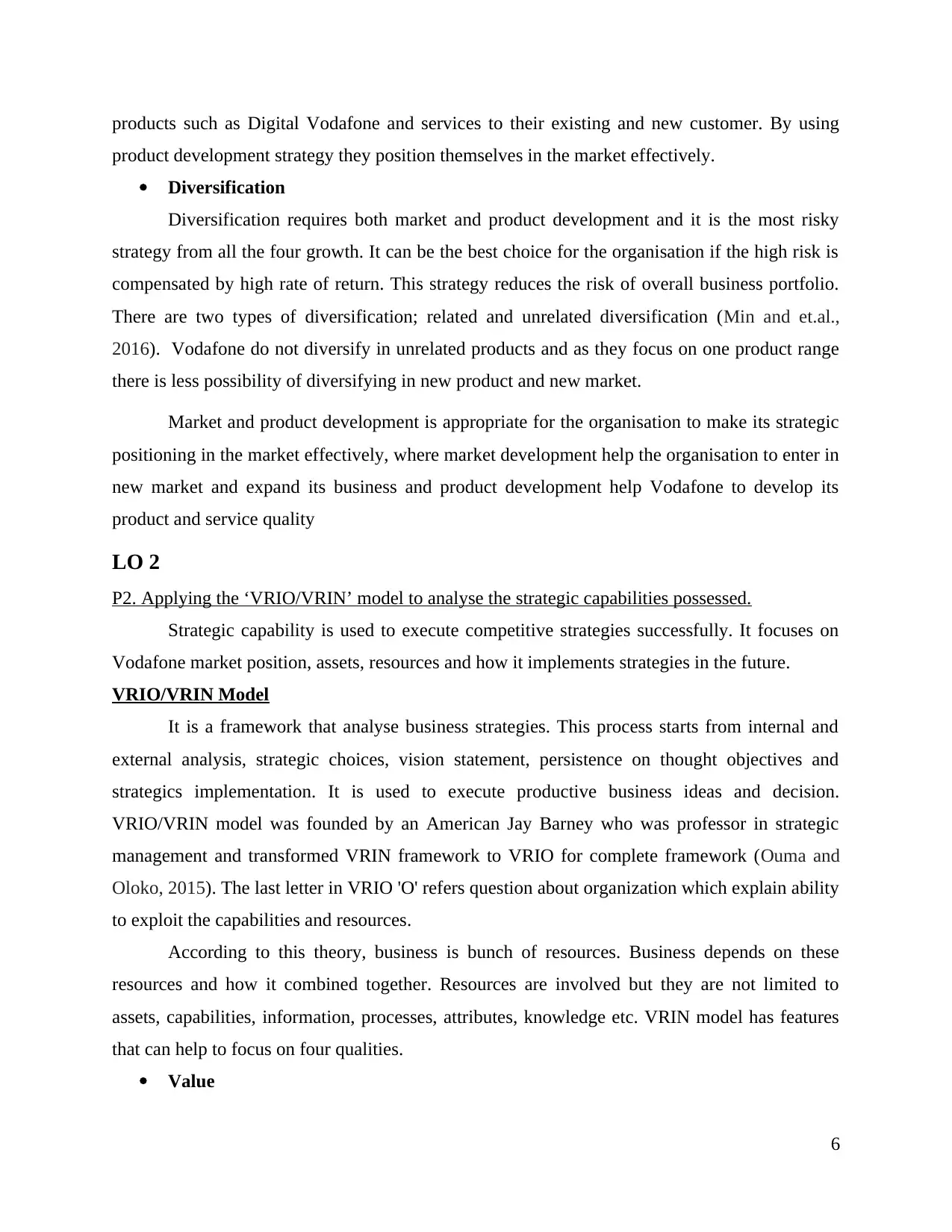
products such as Digital Vodafone and services to their existing and new customer. By using
product development strategy they position themselves in the market effectively.
Diversification
Diversification requires both market and product development and it is the most risky
strategy from all the four growth. It can be the best choice for the organisation if the high risk is
compensated by high rate of return. This strategy reduces the risk of overall business portfolio.
There are two types of diversification; related and unrelated diversification (Min and et.al.,
2016). Vodafone do not diversify in unrelated products and as they focus on one product range
there is less possibility of diversifying in new product and new market.
Market and product development is appropriate for the organisation to make its strategic
positioning in the market effectively, where market development help the organisation to enter in
new market and expand its business and product development help Vodafone to develop its
product and service quality
LO 2
P2. Applying the ‘VRIO/VRIN’ model to analyse the strategic capabilities possessed.
Strategic capability is used to execute competitive strategies successfully. It focuses on
Vodafone market position, assets, resources and how it implements strategies in the future.
VRIO/VRIN Model
It is a framework that analyse business strategies. This process starts from internal and
external analysis, strategic choices, vision statement, persistence on thought objectives and
strategics implementation. It is used to execute productive business ideas and decision.
VRIO/VRIN model was founded by an American Jay Barney who was professor in strategic
management and transformed VRIN framework to VRIO for complete framework (Ouma and
Oloko, 2015). The last letter in VRIO 'O' refers question about organization which explain ability
to exploit the capabilities and resources.
According to this theory, business is bunch of resources. Business depends on these
resources and how it combined together. Resources are involved but they are not limited to
assets, capabilities, information, processes, attributes, knowledge etc. VRIN model has features
that can help to focus on four qualities.
Value
6
product development strategy they position themselves in the market effectively.
Diversification
Diversification requires both market and product development and it is the most risky
strategy from all the four growth. It can be the best choice for the organisation if the high risk is
compensated by high rate of return. This strategy reduces the risk of overall business portfolio.
There are two types of diversification; related and unrelated diversification (Min and et.al.,
2016). Vodafone do not diversify in unrelated products and as they focus on one product range
there is less possibility of diversifying in new product and new market.
Market and product development is appropriate for the organisation to make its strategic
positioning in the market effectively, where market development help the organisation to enter in
new market and expand its business and product development help Vodafone to develop its
product and service quality
LO 2
P2. Applying the ‘VRIO/VRIN’ model to analyse the strategic capabilities possessed.
Strategic capability is used to execute competitive strategies successfully. It focuses on
Vodafone market position, assets, resources and how it implements strategies in the future.
VRIO/VRIN Model
It is a framework that analyse business strategies. This process starts from internal and
external analysis, strategic choices, vision statement, persistence on thought objectives and
strategics implementation. It is used to execute productive business ideas and decision.
VRIO/VRIN model was founded by an American Jay Barney who was professor in strategic
management and transformed VRIN framework to VRIO for complete framework (Ouma and
Oloko, 2015). The last letter in VRIO 'O' refers question about organization which explain ability
to exploit the capabilities and resources.
According to this theory, business is bunch of resources. Business depends on these
resources and how it combined together. Resources are involved but they are not limited to
assets, capabilities, information, processes, attributes, knowledge etc. VRIN model has features
that can help to focus on four qualities.
Value
6
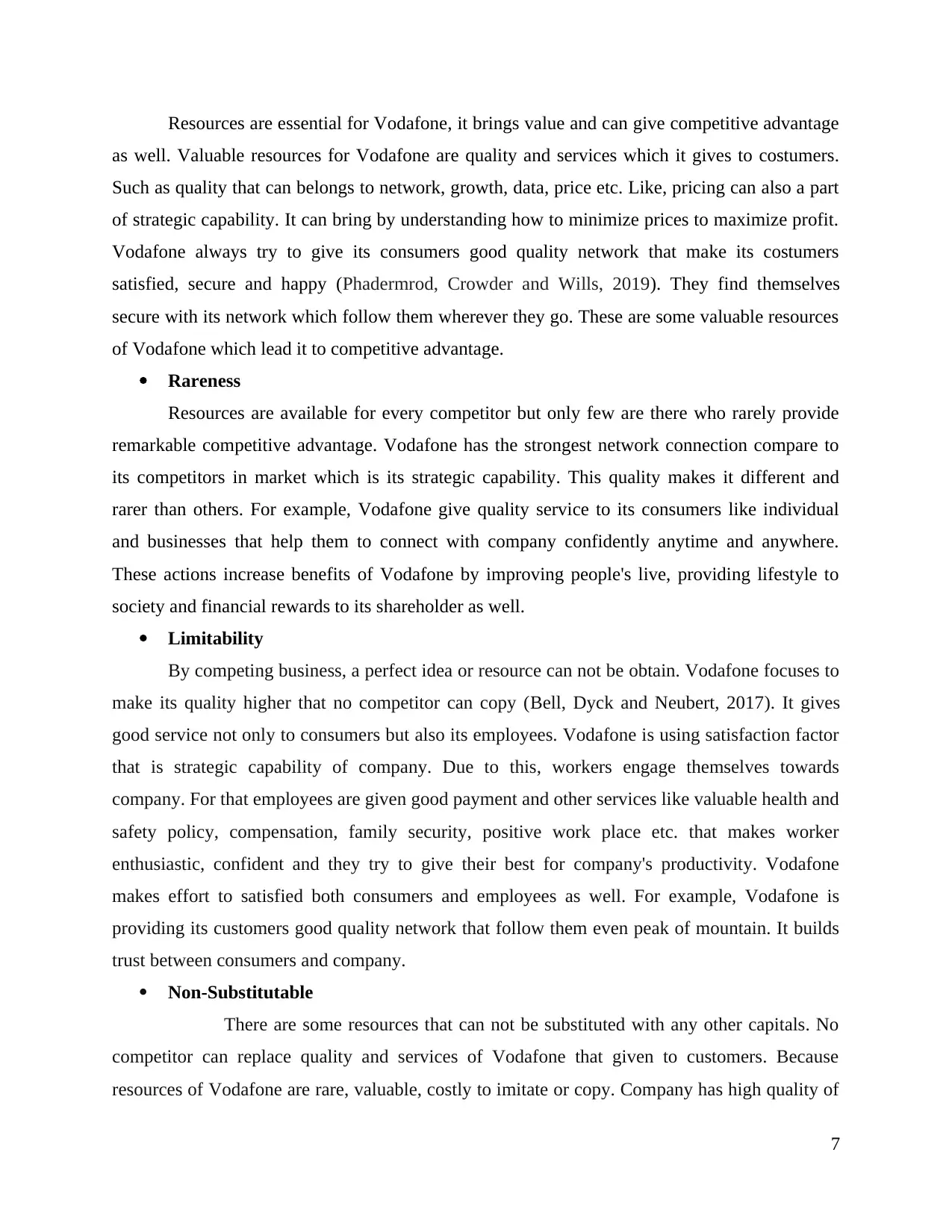
Resources are essential for Vodafone, it brings value and can give competitive advantage
as well. Valuable resources for Vodafone are quality and services which it gives to costumers.
Such as quality that can belongs to network, growth, data, price etc. Like, pricing can also a part
of strategic capability. It can bring by understanding how to minimize prices to maximize profit.
Vodafone always try to give its consumers good quality network that make its costumers
satisfied, secure and happy (Phadermrod, Crowder and Wills, 2019). They find themselves
secure with its network which follow them wherever they go. These are some valuable resources
of Vodafone which lead it to competitive advantage.
Rareness
Resources are available for every competitor but only few are there who rarely provide
remarkable competitive advantage. Vodafone has the strongest network connection compare to
its competitors in market which is its strategic capability. This quality makes it different and
rarer than others. For example, Vodafone give quality service to its consumers like individual
and businesses that help them to connect with company confidently anytime and anywhere.
These actions increase benefits of Vodafone by improving people's live, providing lifestyle to
society and financial rewards to its shareholder as well.
Limitability
By competing business, a perfect idea or resource can not be obtain. Vodafone focuses to
make its quality higher that no competitor can copy (Bell, Dyck and Neubert, 2017). It gives
good service not only to consumers but also its employees. Vodafone is using satisfaction factor
that is strategic capability of company. Due to this, workers engage themselves towards
company. For that employees are given good payment and other services like valuable health and
safety policy, compensation, family security, positive work place etc. that makes worker
enthusiastic, confident and they try to give their best for company's productivity. Vodafone
makes effort to satisfied both consumers and employees as well. For example, Vodafone is
providing its customers good quality network that follow them even peak of mountain. It builds
trust between consumers and company.
Non-Substitutable
There are some resources that can not be substituted with any other capitals. No
competitor can replace quality and services of Vodafone that given to customers. Because
resources of Vodafone are rare, valuable, costly to imitate or copy. Company has high quality of
7
as well. Valuable resources for Vodafone are quality and services which it gives to costumers.
Such as quality that can belongs to network, growth, data, price etc. Like, pricing can also a part
of strategic capability. It can bring by understanding how to minimize prices to maximize profit.
Vodafone always try to give its consumers good quality network that make its costumers
satisfied, secure and happy (Phadermrod, Crowder and Wills, 2019). They find themselves
secure with its network which follow them wherever they go. These are some valuable resources
of Vodafone which lead it to competitive advantage.
Rareness
Resources are available for every competitor but only few are there who rarely provide
remarkable competitive advantage. Vodafone has the strongest network connection compare to
its competitors in market which is its strategic capability. This quality makes it different and
rarer than others. For example, Vodafone give quality service to its consumers like individual
and businesses that help them to connect with company confidently anytime and anywhere.
These actions increase benefits of Vodafone by improving people's live, providing lifestyle to
society and financial rewards to its shareholder as well.
Limitability
By competing business, a perfect idea or resource can not be obtain. Vodafone focuses to
make its quality higher that no competitor can copy (Bell, Dyck and Neubert, 2017). It gives
good service not only to consumers but also its employees. Vodafone is using satisfaction factor
that is strategic capability of company. Due to this, workers engage themselves towards
company. For that employees are given good payment and other services like valuable health and
safety policy, compensation, family security, positive work place etc. that makes worker
enthusiastic, confident and they try to give their best for company's productivity. Vodafone
makes effort to satisfied both consumers and employees as well. For example, Vodafone is
providing its customers good quality network that follow them even peak of mountain. It builds
trust between consumers and company.
Non-Substitutable
There are some resources that can not be substituted with any other capitals. No
competitor can replace quality and services of Vodafone that given to customers. Because
resources of Vodafone are rare, valuable, costly to imitate or copy. Company has high quality of
7
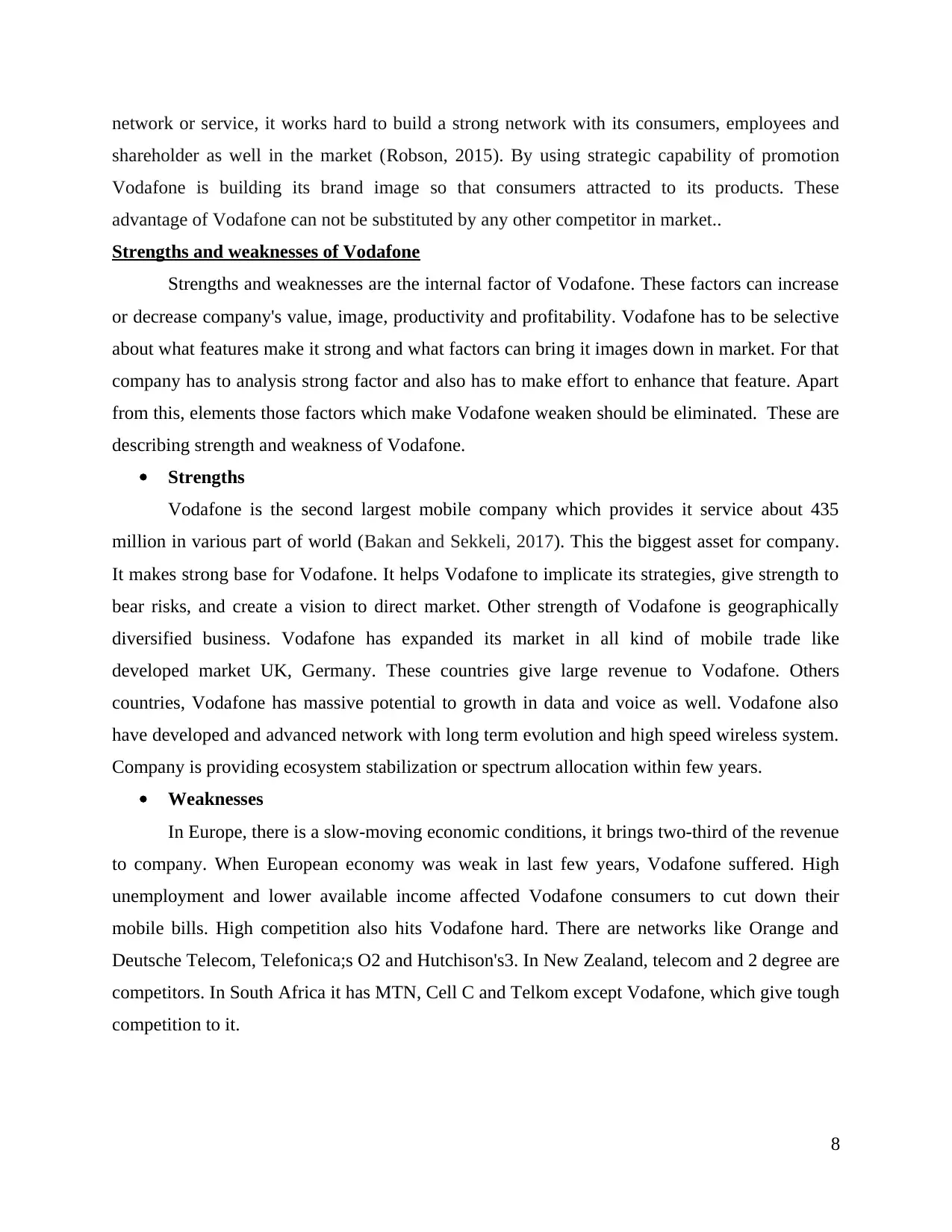
network or service, it works hard to build a strong network with its consumers, employees and
shareholder as well in the market (Robson, 2015). By using strategic capability of promotion
Vodafone is building its brand image so that consumers attracted to its products. These
advantage of Vodafone can not be substituted by any other competitor in market..
Strengths and weaknesses of Vodafone
Strengths and weaknesses are the internal factor of Vodafone. These factors can increase
or decrease company's value, image, productivity and profitability. Vodafone has to be selective
about what features make it strong and what factors can bring it images down in market. For that
company has to analysis strong factor and also has to make effort to enhance that feature. Apart
from this, elements those factors which make Vodafone weaken should be eliminated. These are
describing strength and weakness of Vodafone.
Strengths
Vodafone is the second largest mobile company which provides it service about 435
million in various part of world (Bakan and Sekkeli, 2017). This the biggest asset for company.
It makes strong base for Vodafone. It helps Vodafone to implicate its strategies, give strength to
bear risks, and create a vision to direct market. Other strength of Vodafone is geographically
diversified business. Vodafone has expanded its market in all kind of mobile trade like
developed market UK, Germany. These countries give large revenue to Vodafone. Others
countries, Vodafone has massive potential to growth in data and voice as well. Vodafone also
have developed and advanced network with long term evolution and high speed wireless system.
Company is providing ecosystem stabilization or spectrum allocation within few years.
Weaknesses
In Europe, there is a slow-moving economic conditions, it brings two-third of the revenue
to company. When European economy was weak in last few years, Vodafone suffered. High
unemployment and lower available income affected Vodafone consumers to cut down their
mobile bills. High competition also hits Vodafone hard. There are networks like Orange and
Deutsche Telecom, Telefonica;s O2 and Hutchison's3. In New Zealand, telecom and 2 degree are
competitors. In South Africa it has MTN, Cell C and Telkom except Vodafone, which give tough
competition to it.
8
shareholder as well in the market (Robson, 2015). By using strategic capability of promotion
Vodafone is building its brand image so that consumers attracted to its products. These
advantage of Vodafone can not be substituted by any other competitor in market..
Strengths and weaknesses of Vodafone
Strengths and weaknesses are the internal factor of Vodafone. These factors can increase
or decrease company's value, image, productivity and profitability. Vodafone has to be selective
about what features make it strong and what factors can bring it images down in market. For that
company has to analysis strong factor and also has to make effort to enhance that feature. Apart
from this, elements those factors which make Vodafone weaken should be eliminated. These are
describing strength and weakness of Vodafone.
Strengths
Vodafone is the second largest mobile company which provides it service about 435
million in various part of world (Bakan and Sekkeli, 2017). This the biggest asset for company.
It makes strong base for Vodafone. It helps Vodafone to implicate its strategies, give strength to
bear risks, and create a vision to direct market. Other strength of Vodafone is geographically
diversified business. Vodafone has expanded its market in all kind of mobile trade like
developed market UK, Germany. These countries give large revenue to Vodafone. Others
countries, Vodafone has massive potential to growth in data and voice as well. Vodafone also
have developed and advanced network with long term evolution and high speed wireless system.
Company is providing ecosystem stabilization or spectrum allocation within few years.
Weaknesses
In Europe, there is a slow-moving economic conditions, it brings two-third of the revenue
to company. When European economy was weak in last few years, Vodafone suffered. High
unemployment and lower available income affected Vodafone consumers to cut down their
mobile bills. High competition also hits Vodafone hard. There are networks like Orange and
Deutsche Telecom, Telefonica;s O2 and Hutchison's3. In New Zealand, telecom and 2 degree are
competitors. In South Africa it has MTN, Cell C and Telkom except Vodafone, which give tough
competition to it.
8
Secure Best Marks with AI Grader
Need help grading? Try our AI Grader for instant feedback on your assignments.
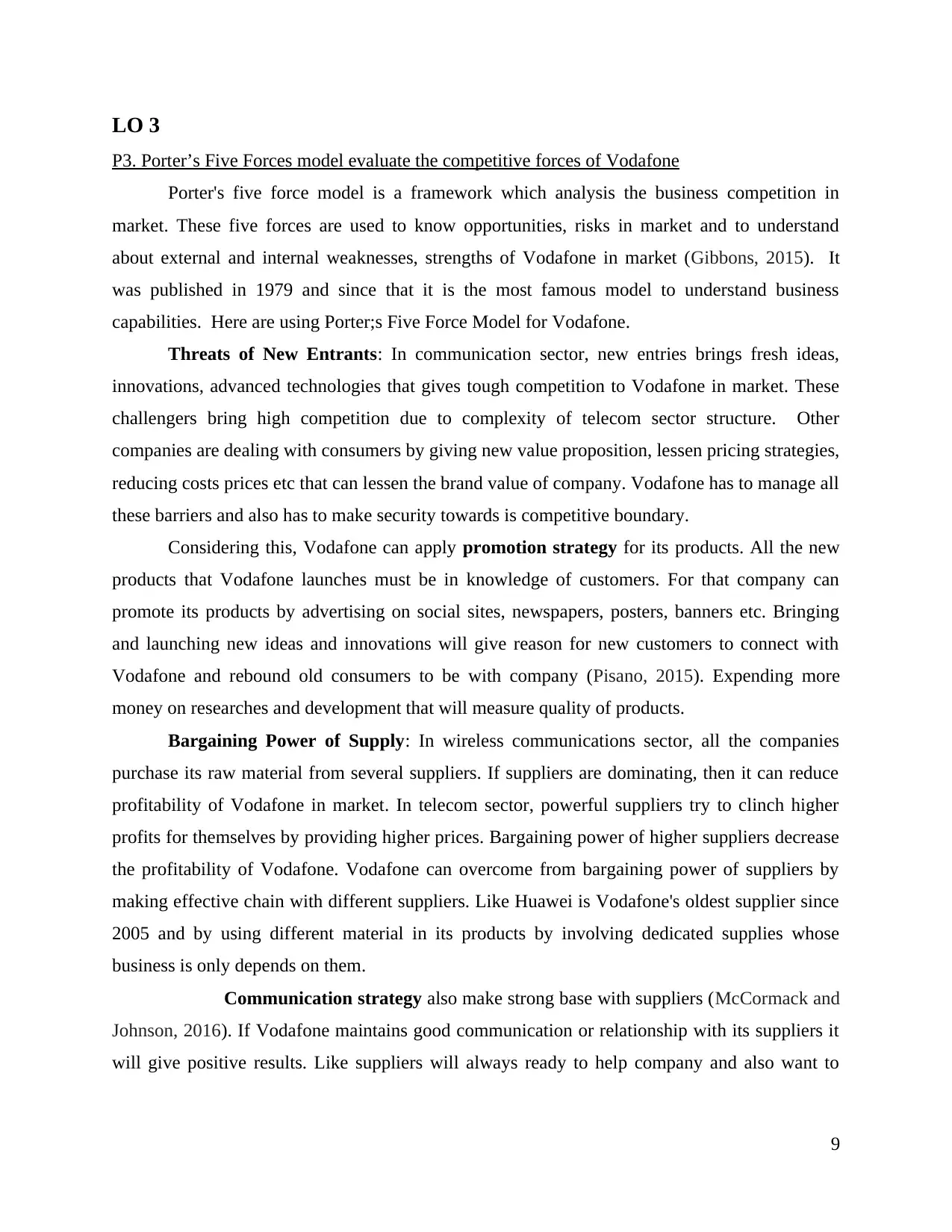
LO 3
P3. Porter’s Five Forces model evaluate the competitive forces of Vodafone
Porter's five force model is a framework which analysis the business competition in
market. These five forces are used to know opportunities, risks in market and to understand
about external and internal weaknesses, strengths of Vodafone in market (Gibbons, 2015). It
was published in 1979 and since that it is the most famous model to understand business
capabilities. Here are using Porter;s Five Force Model for Vodafone.
Threats of New Entrants: In communication sector, new entries brings fresh ideas,
innovations, advanced technologies that gives tough competition to Vodafone in market. These
challengers bring high competition due to complexity of telecom sector structure. Other
companies are dealing with consumers by giving new value proposition, lessen pricing strategies,
reducing costs prices etc that can lessen the brand value of company. Vodafone has to manage all
these barriers and also has to make security towards is competitive boundary.
Considering this, Vodafone can apply promotion strategy for its products. All the new
products that Vodafone launches must be in knowledge of customers. For that company can
promote its products by advertising on social sites, newspapers, posters, banners etc. Bringing
and launching new ideas and innovations will give reason for new customers to connect with
Vodafone and rebound old consumers to be with company (Pisano, 2015). Expending more
money on researches and development that will measure quality of products.
Bargaining Power of Supply: In wireless communications sector, all the companies
purchase its raw material from several suppliers. If suppliers are dominating, then it can reduce
profitability of Vodafone in market. In telecom sector, powerful suppliers try to clinch higher
profits for themselves by providing higher prices. Bargaining power of higher suppliers decrease
the profitability of Vodafone. Vodafone can overcome from bargaining power of suppliers by
making effective chain with different suppliers. Like Huawei is Vodafone's oldest supplier since
2005 and by using different material in its products by involving dedicated supplies whose
business is only depends on them.
Communication strategy also make strong base with suppliers (McCormack and
Johnson, 2016). If Vodafone maintains good communication or relationship with its suppliers it
will give positive results. Like suppliers will always ready to help company and also want to
9
P3. Porter’s Five Forces model evaluate the competitive forces of Vodafone
Porter's five force model is a framework which analysis the business competition in
market. These five forces are used to know opportunities, risks in market and to understand
about external and internal weaknesses, strengths of Vodafone in market (Gibbons, 2015). It
was published in 1979 and since that it is the most famous model to understand business
capabilities. Here are using Porter;s Five Force Model for Vodafone.
Threats of New Entrants: In communication sector, new entries brings fresh ideas,
innovations, advanced technologies that gives tough competition to Vodafone in market. These
challengers bring high competition due to complexity of telecom sector structure. Other
companies are dealing with consumers by giving new value proposition, lessen pricing strategies,
reducing costs prices etc that can lessen the brand value of company. Vodafone has to manage all
these barriers and also has to make security towards is competitive boundary.
Considering this, Vodafone can apply promotion strategy for its products. All the new
products that Vodafone launches must be in knowledge of customers. For that company can
promote its products by advertising on social sites, newspapers, posters, banners etc. Bringing
and launching new ideas and innovations will give reason for new customers to connect with
Vodafone and rebound old consumers to be with company (Pisano, 2015). Expending more
money on researches and development that will measure quality of products.
Bargaining Power of Supply: In wireless communications sector, all the companies
purchase its raw material from several suppliers. If suppliers are dominating, then it can reduce
profitability of Vodafone in market. In telecom sector, powerful suppliers try to clinch higher
profits for themselves by providing higher prices. Bargaining power of higher suppliers decrease
the profitability of Vodafone. Vodafone can overcome from bargaining power of suppliers by
making effective chain with different suppliers. Like Huawei is Vodafone's oldest supplier since
2005 and by using different material in its products by involving dedicated supplies whose
business is only depends on them.
Communication strategy also make strong base with suppliers (McCormack and
Johnson, 2016). If Vodafone maintains good communication or relationship with its suppliers it
will give positive results. Like suppliers will always ready to help company and also want to
9
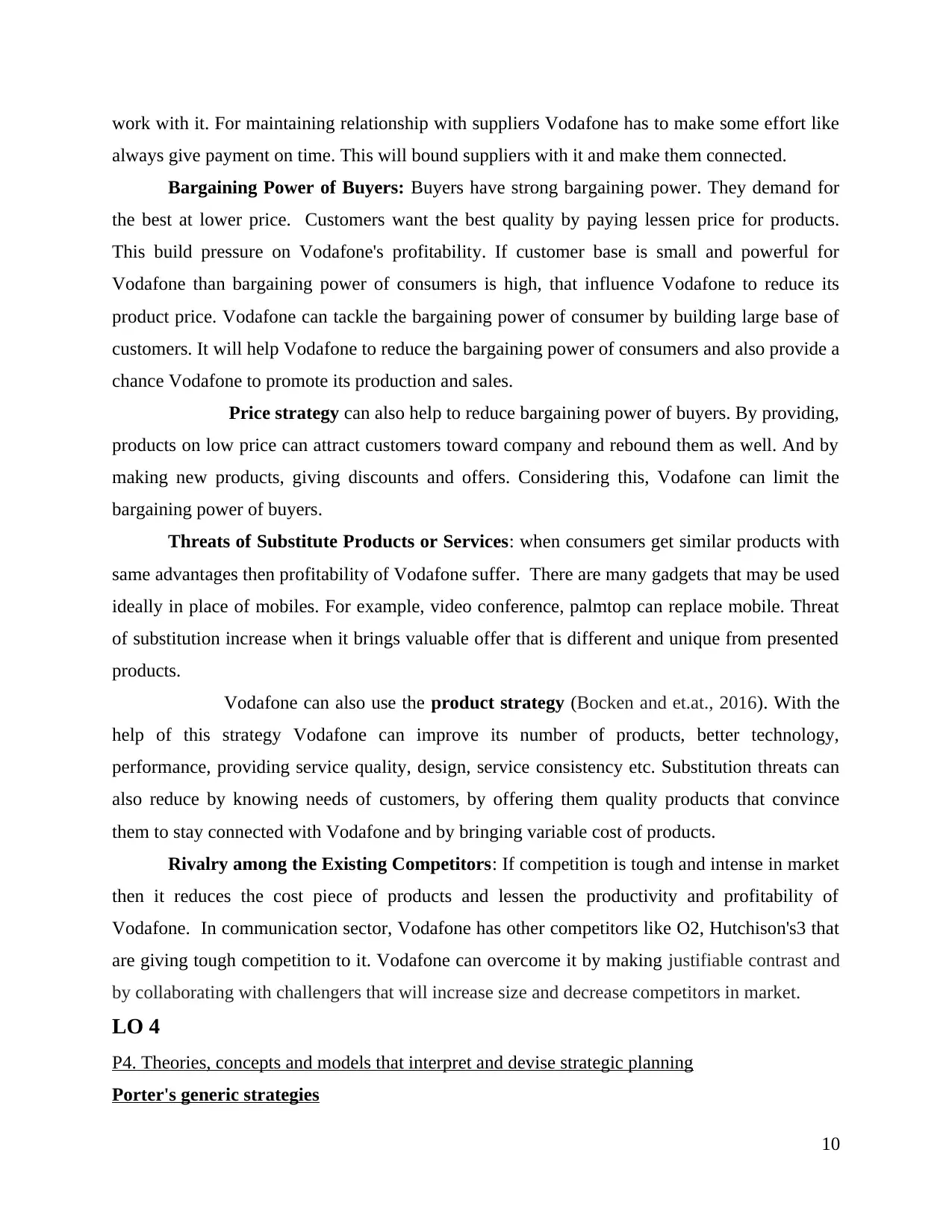
work with it. For maintaining relationship with suppliers Vodafone has to make some effort like
always give payment on time. This will bound suppliers with it and make them connected.
Bargaining Power of Buyers: Buyers have strong bargaining power. They demand for
the best at lower price. Customers want the best quality by paying lessen price for products.
This build pressure on Vodafone's profitability. If customer base is small and powerful for
Vodafone than bargaining power of consumers is high, that influence Vodafone to reduce its
product price. Vodafone can tackle the bargaining power of consumer by building large base of
customers. It will help Vodafone to reduce the bargaining power of consumers and also provide a
chance Vodafone to promote its production and sales.
Price strategy can also help to reduce bargaining power of buyers. By providing,
products on low price can attract customers toward company and rebound them as well. And by
making new products, giving discounts and offers. Considering this, Vodafone can limit the
bargaining power of buyers.
Threats of Substitute Products or Services: when consumers get similar products with
same advantages then profitability of Vodafone suffer. There are many gadgets that may be used
ideally in place of mobiles. For example, video conference, palmtop can replace mobile. Threat
of substitution increase when it brings valuable offer that is different and unique from presented
products.
Vodafone can also use the product strategy (Bocken and et.at., 2016). With the
help of this strategy Vodafone can improve its number of products, better technology,
performance, providing service quality, design, service consistency etc. Substitution threats can
also reduce by knowing needs of customers, by offering them quality products that convince
them to stay connected with Vodafone and by bringing variable cost of products.
Rivalry among the Existing Competitors: If competition is tough and intense in market
then it reduces the cost piece of products and lessen the productivity and profitability of
Vodafone. In communication sector, Vodafone has other competitors like O2, Hutchison's3 that
are giving tough competition to it. Vodafone can overcome it by making justifiable contrast and
by collaborating with challengers that will increase size and decrease competitors in market.
LO 4
P4. Theories, concepts and models that interpret and devise strategic planning
Porter's generic strategies
10
always give payment on time. This will bound suppliers with it and make them connected.
Bargaining Power of Buyers: Buyers have strong bargaining power. They demand for
the best at lower price. Customers want the best quality by paying lessen price for products.
This build pressure on Vodafone's profitability. If customer base is small and powerful for
Vodafone than bargaining power of consumers is high, that influence Vodafone to reduce its
product price. Vodafone can tackle the bargaining power of consumer by building large base of
customers. It will help Vodafone to reduce the bargaining power of consumers and also provide a
chance Vodafone to promote its production and sales.
Price strategy can also help to reduce bargaining power of buyers. By providing,
products on low price can attract customers toward company and rebound them as well. And by
making new products, giving discounts and offers. Considering this, Vodafone can limit the
bargaining power of buyers.
Threats of Substitute Products or Services: when consumers get similar products with
same advantages then profitability of Vodafone suffer. There are many gadgets that may be used
ideally in place of mobiles. For example, video conference, palmtop can replace mobile. Threat
of substitution increase when it brings valuable offer that is different and unique from presented
products.
Vodafone can also use the product strategy (Bocken and et.at., 2016). With the
help of this strategy Vodafone can improve its number of products, better technology,
performance, providing service quality, design, service consistency etc. Substitution threats can
also reduce by knowing needs of customers, by offering them quality products that convince
them to stay connected with Vodafone and by bringing variable cost of products.
Rivalry among the Existing Competitors: If competition is tough and intense in market
then it reduces the cost piece of products and lessen the productivity and profitability of
Vodafone. In communication sector, Vodafone has other competitors like O2, Hutchison's3 that
are giving tough competition to it. Vodafone can overcome it by making justifiable contrast and
by collaborating with challengers that will increase size and decrease competitors in market.
LO 4
P4. Theories, concepts and models that interpret and devise strategic planning
Porter's generic strategies
10
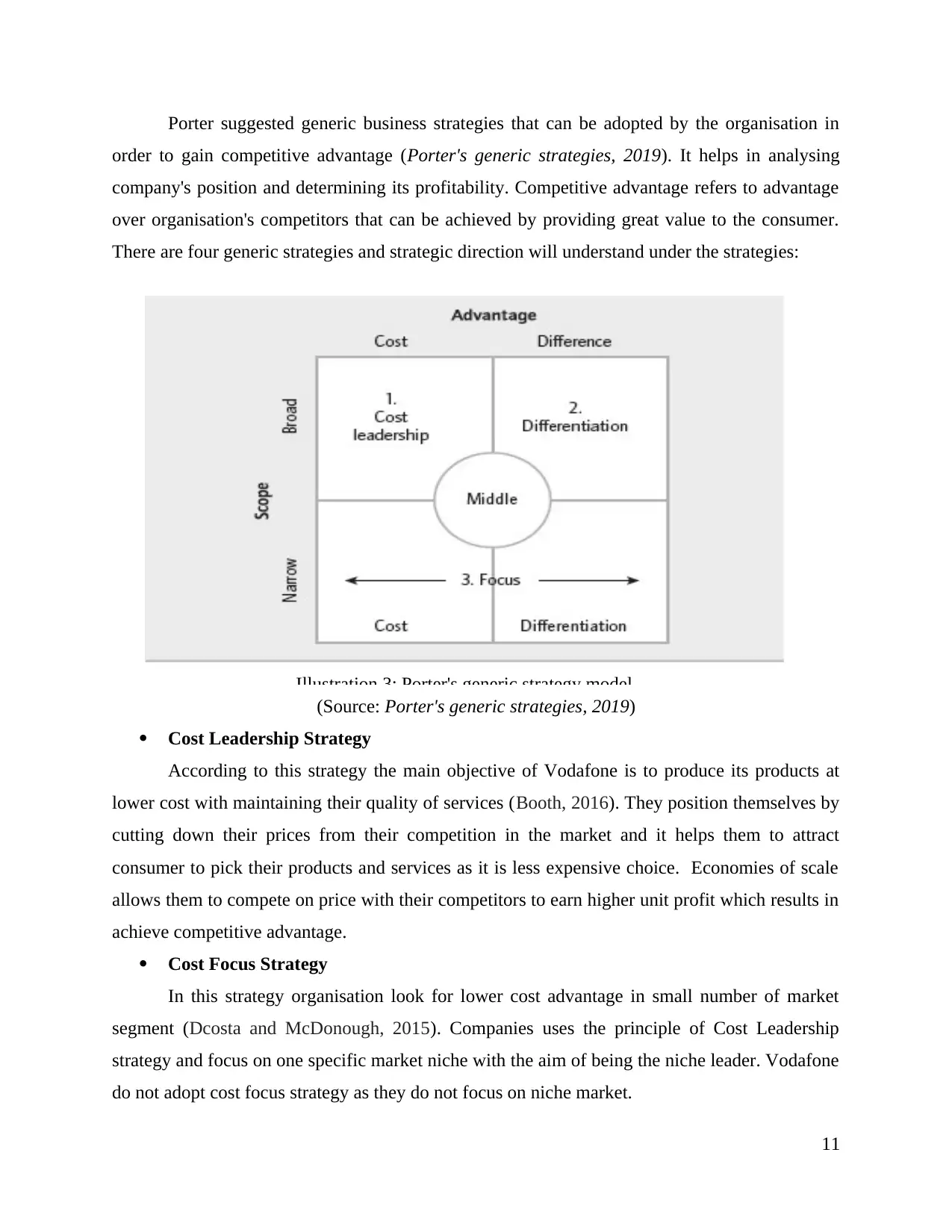
Porter suggested generic business strategies that can be adopted by the organisation in
order to gain competitive advantage (Porter's generic strategies, 2019). It helps in analysing
company's position and determining its profitability. Competitive advantage refers to advantage
over organisation's competitors that can be achieved by providing great value to the consumer.
There are four generic strategies and strategic direction will understand under the strategies:
(Source: Porter's generic strategies, 2019)
Cost Leadership Strategy
According to this strategy the main objective of Vodafone is to produce its products at
lower cost with maintaining their quality of services (Booth, 2016). They position themselves by
cutting down their prices from their competition in the market and it helps them to attract
consumer to pick their products and services as it is less expensive choice. Economies of scale
allows them to compete on price with their competitors to earn higher unit profit which results in
achieve competitive advantage.
Cost Focus Strategy
In this strategy organisation look for lower cost advantage in small number of market
segment (Dcosta and McDonough, 2015). Companies uses the principle of Cost Leadership
strategy and focus on one specific market niche with the aim of being the niche leader. Vodafone
do not adopt cost focus strategy as they do not focus on niche market.
11
Illustration 3: Porter's generic strategy model
order to gain competitive advantage (Porter's generic strategies, 2019). It helps in analysing
company's position and determining its profitability. Competitive advantage refers to advantage
over organisation's competitors that can be achieved by providing great value to the consumer.
There are four generic strategies and strategic direction will understand under the strategies:
(Source: Porter's generic strategies, 2019)
Cost Leadership Strategy
According to this strategy the main objective of Vodafone is to produce its products at
lower cost with maintaining their quality of services (Booth, 2016). They position themselves by
cutting down their prices from their competition in the market and it helps them to attract
consumer to pick their products and services as it is less expensive choice. Economies of scale
allows them to compete on price with their competitors to earn higher unit profit which results in
achieve competitive advantage.
Cost Focus Strategy
In this strategy organisation look for lower cost advantage in small number of market
segment (Dcosta and McDonough, 2015). Companies uses the principle of Cost Leadership
strategy and focus on one specific market niche with the aim of being the niche leader. Vodafone
do not adopt cost focus strategy as they do not focus on niche market.
11
Illustration 3: Porter's generic strategy model
Paraphrase This Document
Need a fresh take? Get an instant paraphrase of this document with our AI Paraphraser
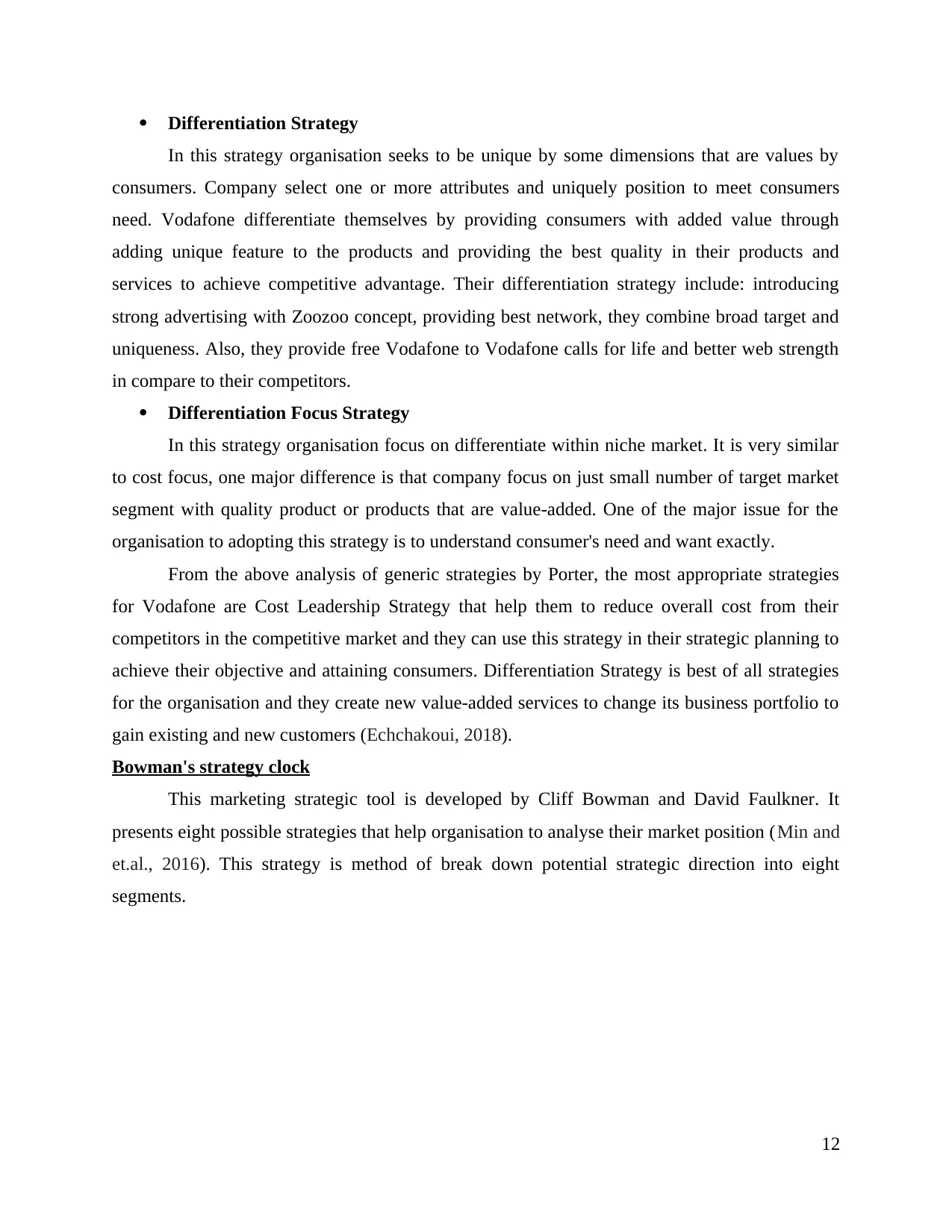
Differentiation Strategy
In this strategy organisation seeks to be unique by some dimensions that are values by
consumers. Company select one or more attributes and uniquely position to meet consumers
need. Vodafone differentiate themselves by providing consumers with added value through
adding unique feature to the products and providing the best quality in their products and
services to achieve competitive advantage. Their differentiation strategy include: introducing
strong advertising with Zoozoo concept, providing best network, they combine broad target and
uniqueness. Also, they provide free Vodafone to Vodafone calls for life and better web strength
in compare to their competitors.
Differentiation Focus Strategy
In this strategy organisation focus on differentiate within niche market. It is very similar
to cost focus, one major difference is that company focus on just small number of target market
segment with quality product or products that are value-added. One of the major issue for the
organisation to adopting this strategy is to understand consumer's need and want exactly.
From the above analysis of generic strategies by Porter, the most appropriate strategies
for Vodafone are Cost Leadership Strategy that help them to reduce overall cost from their
competitors in the competitive market and they can use this strategy in their strategic planning to
achieve their objective and attaining consumers. Differentiation Strategy is best of all strategies
for the organisation and they create new value-added services to change its business portfolio to
gain existing and new customers (Echchakoui, 2018).
Bowman's strategy clock
This marketing strategic tool is developed by Cliff Bowman and David Faulkner. It
presents eight possible strategies that help organisation to analyse their market position (Min and
et.al., 2016). This strategy is method of break down potential strategic direction into eight
segments.
12
In this strategy organisation seeks to be unique by some dimensions that are values by
consumers. Company select one or more attributes and uniquely position to meet consumers
need. Vodafone differentiate themselves by providing consumers with added value through
adding unique feature to the products and providing the best quality in their products and
services to achieve competitive advantage. Their differentiation strategy include: introducing
strong advertising with Zoozoo concept, providing best network, they combine broad target and
uniqueness. Also, they provide free Vodafone to Vodafone calls for life and better web strength
in compare to their competitors.
Differentiation Focus Strategy
In this strategy organisation focus on differentiate within niche market. It is very similar
to cost focus, one major difference is that company focus on just small number of target market
segment with quality product or products that are value-added. One of the major issue for the
organisation to adopting this strategy is to understand consumer's need and want exactly.
From the above analysis of generic strategies by Porter, the most appropriate strategies
for Vodafone are Cost Leadership Strategy that help them to reduce overall cost from their
competitors in the competitive market and they can use this strategy in their strategic planning to
achieve their objective and attaining consumers. Differentiation Strategy is best of all strategies
for the organisation and they create new value-added services to change its business portfolio to
gain existing and new customers (Echchakoui, 2018).
Bowman's strategy clock
This marketing strategic tool is developed by Cliff Bowman and David Faulkner. It
presents eight possible strategies that help organisation to analyse their market position (Min and
et.al., 2016). This strategy is method of break down potential strategic direction into eight
segments.
12
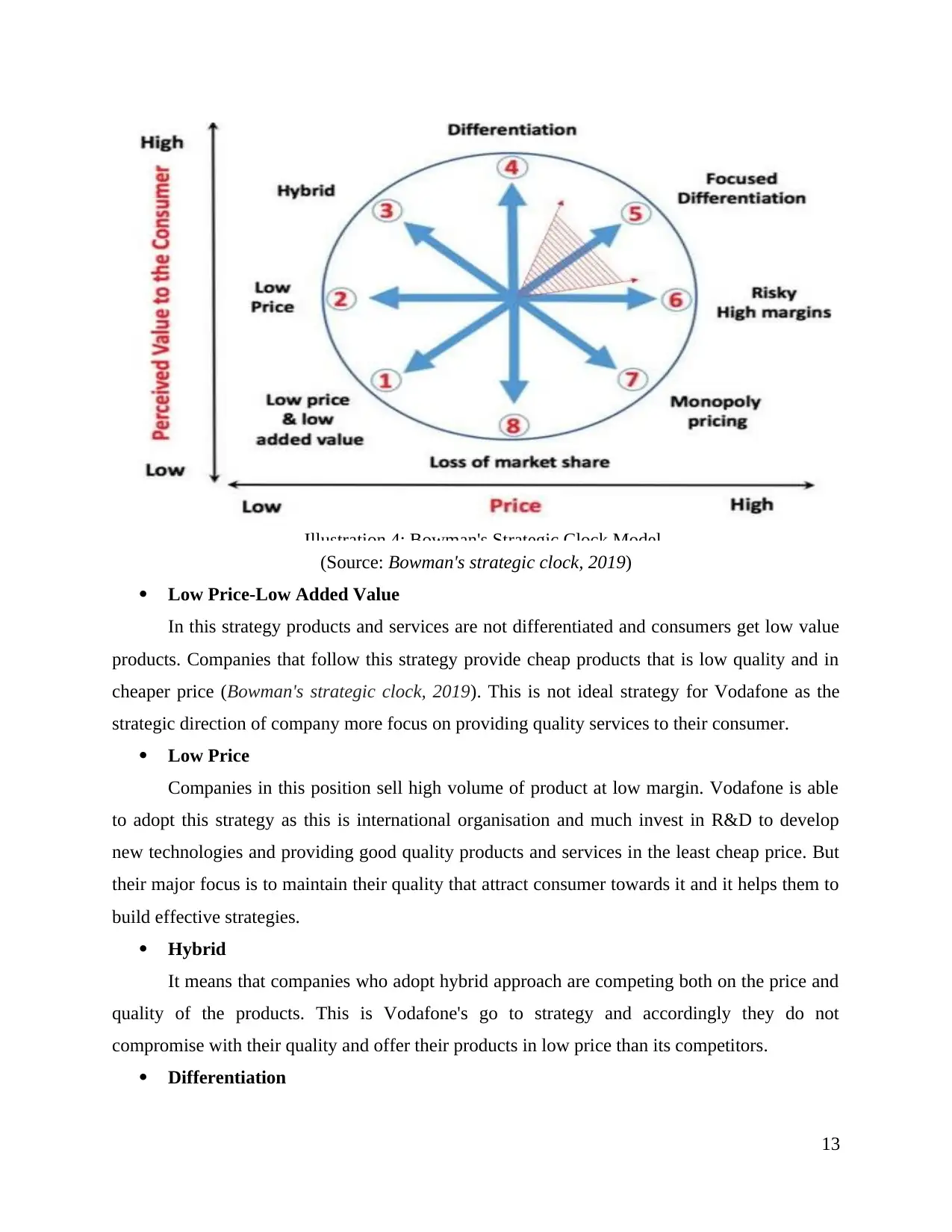
(Source: Bowman's strategic clock, 2019)
Low Price-Low Added Value
In this strategy products and services are not differentiated and consumers get low value
products. Companies that follow this strategy provide cheap products that is low quality and in
cheaper price (Bowman's strategic clock, 2019). This is not ideal strategy for Vodafone as the
strategic direction of company more focus on providing quality services to their consumer.
Low Price
Companies in this position sell high volume of product at low margin. Vodafone is able
to adopt this strategy as this is international organisation and much invest in R&D to develop
new technologies and providing good quality products and services in the least cheap price. But
their major focus is to maintain their quality that attract consumer towards it and it helps them to
build effective strategies.
Hybrid
It means that companies who adopt hybrid approach are competing both on the price and
quality of the products. This is Vodafone's go to strategy and accordingly they do not
compromise with their quality and offer their products in low price than its competitors.
Differentiation
13
Illustration 4: Bowman's Strategic Clock Model
Low Price-Low Added Value
In this strategy products and services are not differentiated and consumers get low value
products. Companies that follow this strategy provide cheap products that is low quality and in
cheaper price (Bowman's strategic clock, 2019). This is not ideal strategy for Vodafone as the
strategic direction of company more focus on providing quality services to their consumer.
Low Price
Companies in this position sell high volume of product at low margin. Vodafone is able
to adopt this strategy as this is international organisation and much invest in R&D to develop
new technologies and providing good quality products and services in the least cheap price. But
their major focus is to maintain their quality that attract consumer towards it and it helps them to
build effective strategies.
Hybrid
It means that companies who adopt hybrid approach are competing both on the price and
quality of the products. This is Vodafone's go to strategy and accordingly they do not
compromise with their quality and offer their products in low price than its competitors.
Differentiation
13
Illustration 4: Bowman's Strategic Clock Model
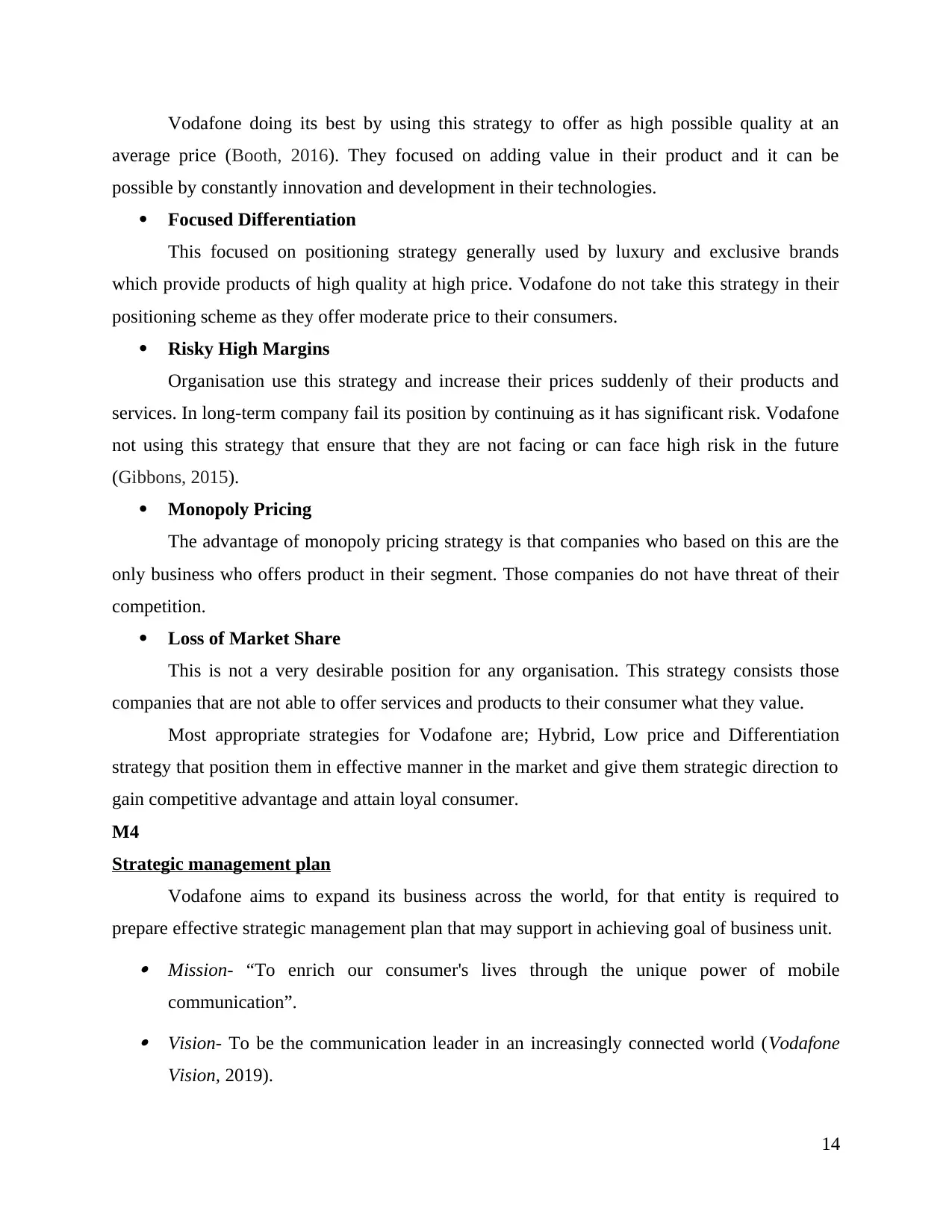
Vodafone doing its best by using this strategy to offer as high possible quality at an
average price (Booth, 2016). They focused on adding value in their product and it can be
possible by constantly innovation and development in their technologies.
Focused Differentiation
This focused on positioning strategy generally used by luxury and exclusive brands
which provide products of high quality at high price. Vodafone do not take this strategy in their
positioning scheme as they offer moderate price to their consumers.
Risky High Margins
Organisation use this strategy and increase their prices suddenly of their products and
services. In long-term company fail its position by continuing as it has significant risk. Vodafone
not using this strategy that ensure that they are not facing or can face high risk in the future
(Gibbons, 2015).
Monopoly Pricing
The advantage of monopoly pricing strategy is that companies who based on this are the
only business who offers product in their segment. Those companies do not have threat of their
competition.
Loss of Market Share
This is not a very desirable position for any organisation. This strategy consists those
companies that are not able to offer services and products to their consumer what they value.
Most appropriate strategies for Vodafone are; Hybrid, Low price and Differentiation
strategy that position them in effective manner in the market and give them strategic direction to
gain competitive advantage and attain loyal consumer.
M4
Strategic management plan
Vodafone aims to expand its business across the world, for that entity is required to
prepare effective strategic management plan that may support in achieving goal of business unit. Mission- “To enrich our consumer's lives through the unique power of mobile
communication”. Vision- To be the communication leader in an increasingly connected world (Vodafone
Vision, 2019).
14
average price (Booth, 2016). They focused on adding value in their product and it can be
possible by constantly innovation and development in their technologies.
Focused Differentiation
This focused on positioning strategy generally used by luxury and exclusive brands
which provide products of high quality at high price. Vodafone do not take this strategy in their
positioning scheme as they offer moderate price to their consumers.
Risky High Margins
Organisation use this strategy and increase their prices suddenly of their products and
services. In long-term company fail its position by continuing as it has significant risk. Vodafone
not using this strategy that ensure that they are not facing or can face high risk in the future
(Gibbons, 2015).
Monopoly Pricing
The advantage of monopoly pricing strategy is that companies who based on this are the
only business who offers product in their segment. Those companies do not have threat of their
competition.
Loss of Market Share
This is not a very desirable position for any organisation. This strategy consists those
companies that are not able to offer services and products to their consumer what they value.
Most appropriate strategies for Vodafone are; Hybrid, Low price and Differentiation
strategy that position them in effective manner in the market and give them strategic direction to
gain competitive advantage and attain loyal consumer.
M4
Strategic management plan
Vodafone aims to expand its business across the world, for that entity is required to
prepare effective strategic management plan that may support in achieving goal of business unit. Mission- “To enrich our consumer's lives through the unique power of mobile
communication”. Vision- To be the communication leader in an increasingly connected world (Vodafone
Vision, 2019).
14
Secure Best Marks with AI Grader
Need help grading? Try our AI Grader for instant feedback on your assignments.
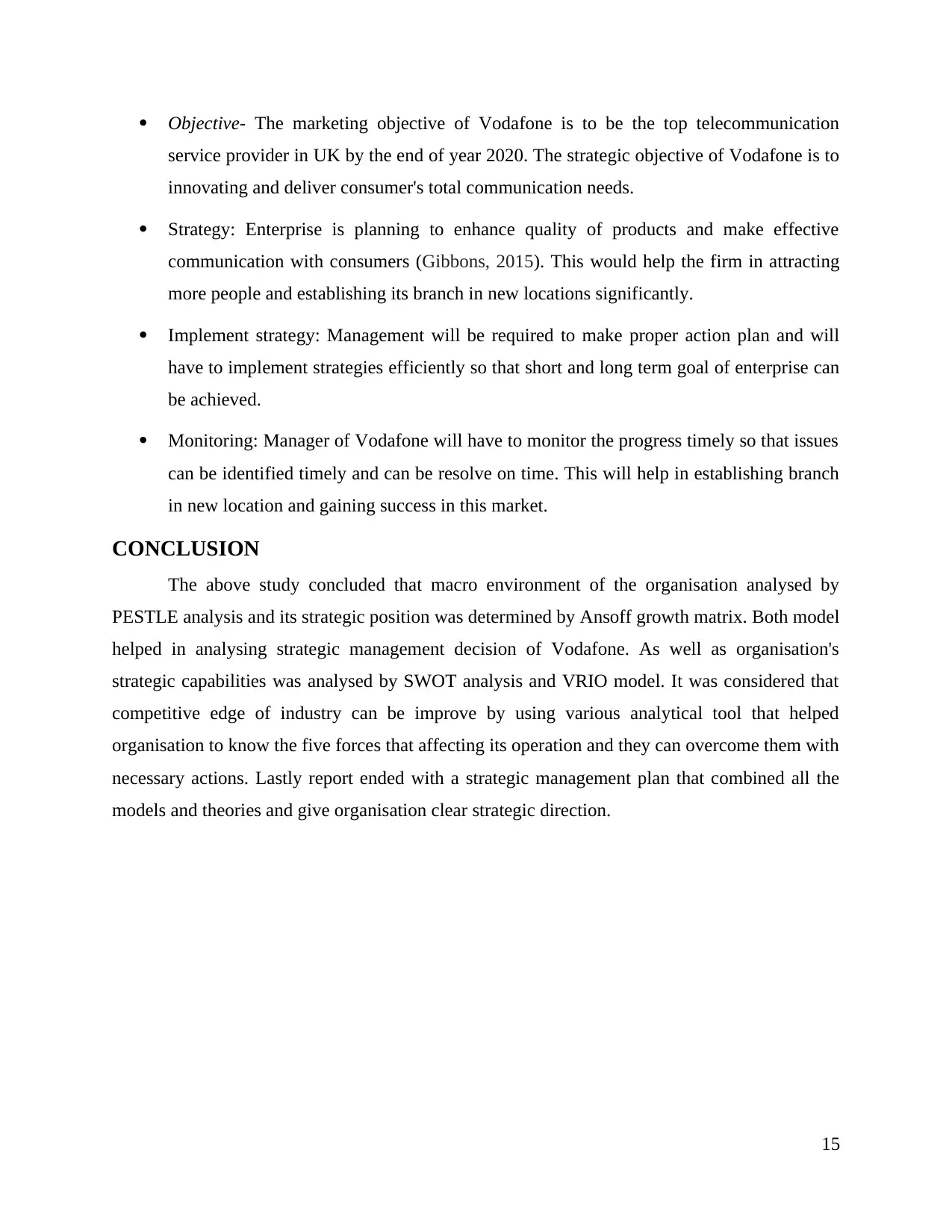
Objective- The marketing objective of Vodafone is to be the top telecommunication
service provider in UK by the end of year 2020. The strategic objective of Vodafone is to
innovating and deliver consumer's total communication needs.
Strategy: Enterprise is planning to enhance quality of products and make effective
communication with consumers (Gibbons, 2015). This would help the firm in attracting
more people and establishing its branch in new locations significantly.
Implement strategy: Management will be required to make proper action plan and will
have to implement strategies efficiently so that short and long term goal of enterprise can
be achieved.
Monitoring: Manager of Vodafone will have to monitor the progress timely so that issues
can be identified timely and can be resolve on time. This will help in establishing branch
in new location and gaining success in this market.
CONCLUSION
The above study concluded that macro environment of the organisation analysed by
PESTLE analysis and its strategic position was determined by Ansoff growth matrix. Both model
helped in analysing strategic management decision of Vodafone. As well as organisation's
strategic capabilities was analysed by SWOT analysis and VRIO model. It was considered that
competitive edge of industry can be improve by using various analytical tool that helped
organisation to know the five forces that affecting its operation and they can overcome them with
necessary actions. Lastly report ended with a strategic management plan that combined all the
models and theories and give organisation clear strategic direction.
15
service provider in UK by the end of year 2020. The strategic objective of Vodafone is to
innovating and deliver consumer's total communication needs.
Strategy: Enterprise is planning to enhance quality of products and make effective
communication with consumers (Gibbons, 2015). This would help the firm in attracting
more people and establishing its branch in new locations significantly.
Implement strategy: Management will be required to make proper action plan and will
have to implement strategies efficiently so that short and long term goal of enterprise can
be achieved.
Monitoring: Manager of Vodafone will have to monitor the progress timely so that issues
can be identified timely and can be resolve on time. This will help in establishing branch
in new location and gaining success in this market.
CONCLUSION
The above study concluded that macro environment of the organisation analysed by
PESTLE analysis and its strategic position was determined by Ansoff growth matrix. Both model
helped in analysing strategic management decision of Vodafone. As well as organisation's
strategic capabilities was analysed by SWOT analysis and VRIO model. It was considered that
competitive edge of industry can be improve by using various analytical tool that helped
organisation to know the five forces that affecting its operation and they can overcome them with
necessary actions. Lastly report ended with a strategic management plan that combined all the
models and theories and give organisation clear strategic direction.
15
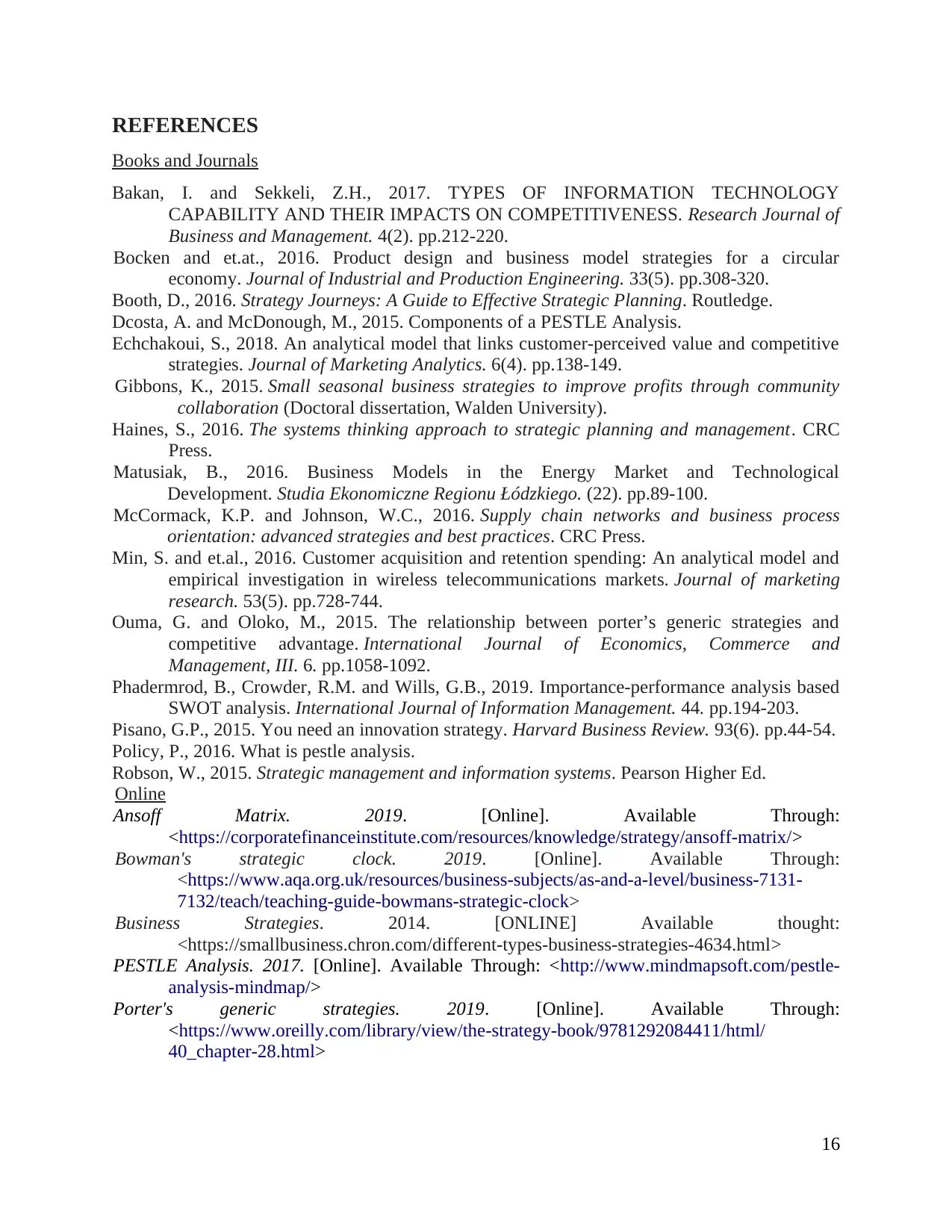
REFERENCES
Books and Journals
Bakan, I. and Sekkeli, Z.H., 2017. TYPES OF INFORMATION TECHNOLOGY
CAPABILITY AND THEIR IMPACTS ON COMPETITIVENESS. Research Journal of
Business and Management. 4(2). pp.212-220.
Bocken and et.at., 2016. Product design and business model strategies for a circular
economy. Journal of Industrial and Production Engineering. 33(5). pp.308-320.
Booth, D., 2016. Strategy Journeys: A Guide to Effective Strategic Planning. Routledge.
Dcosta, A. and McDonough, M., 2015. Components of a PESTLE Analysis.
Echchakoui, S., 2018. An analytical model that links customer-perceived value and competitive
strategies. Journal of Marketing Analytics. 6(4). pp.138-149.
Gibbons, K., 2015. Small seasonal business strategies to improve profits through community
collaboration (Doctoral dissertation, Walden University).
Haines, S., 2016. The systems thinking approach to strategic planning and management. CRC
Press.
Matusiak, B., 2016. Business Models in the Energy Market and Technological
Development. Studia Ekonomiczne Regionu Łódzkiego. (22). pp.89-100.
McCormack, K.P. and Johnson, W.C., 2016. Supply chain networks and business process
orientation: advanced strategies and best practices. CRC Press.
Min, S. and et.al., 2016. Customer acquisition and retention spending: An analytical model and
empirical investigation in wireless telecommunications markets. Journal of marketing
research. 53(5). pp.728-744.
Ouma, G. and Oloko, M., 2015. The relationship between porter’s generic strategies and
competitive advantage. International Journal of Economics, Commerce and
Management, III. 6. pp.1058-1092.
Phadermrod, B., Crowder, R.M. and Wills, G.B., 2019. Importance-performance analysis based
SWOT analysis. International Journal of Information Management. 44. pp.194-203.
Pisano, G.P., 2015. You need an innovation strategy. Harvard Business Review. 93(6). pp.44-54.
Policy, P., 2016. What is pestle analysis.
Robson, W., 2015. Strategic management and information systems. Pearson Higher Ed.
Online
Ansoff Matrix. 2019. [Online]. Available Through:
<https://corporatefinanceinstitute.com/resources/knowledge/strategy/ansoff-matrix/>
Bowman's strategic clock. 2019. [Online]. Available Through:
<https://www.aqa.org.uk/resources/business-subjects/as-and-a-level/business-7131-
7132/teach/teaching-guide-bowmans-strategic-clock>
Business Strategies. 2014. [ONLINE] Available thought:
<https://smallbusiness.chron.com/different-types-business-strategies-4634.html>
PESTLE Analysis. 2017. [Online]. Available Through: <http://www.mindmapsoft.com/pestle-
analysis-mindmap/>
Porter's generic strategies. 2019. [Online]. Available Through:
<https://www.oreilly.com/library/view/the-strategy-book/9781292084411/html/
40_chapter-28.html>
16
Books and Journals
Bakan, I. and Sekkeli, Z.H., 2017. TYPES OF INFORMATION TECHNOLOGY
CAPABILITY AND THEIR IMPACTS ON COMPETITIVENESS. Research Journal of
Business and Management. 4(2). pp.212-220.
Bocken and et.at., 2016. Product design and business model strategies for a circular
economy. Journal of Industrial and Production Engineering. 33(5). pp.308-320.
Booth, D., 2016. Strategy Journeys: A Guide to Effective Strategic Planning. Routledge.
Dcosta, A. and McDonough, M., 2015. Components of a PESTLE Analysis.
Echchakoui, S., 2018. An analytical model that links customer-perceived value and competitive
strategies. Journal of Marketing Analytics. 6(4). pp.138-149.
Gibbons, K., 2015. Small seasonal business strategies to improve profits through community
collaboration (Doctoral dissertation, Walden University).
Haines, S., 2016. The systems thinking approach to strategic planning and management. CRC
Press.
Matusiak, B., 2016. Business Models in the Energy Market and Technological
Development. Studia Ekonomiczne Regionu Łódzkiego. (22). pp.89-100.
McCormack, K.P. and Johnson, W.C., 2016. Supply chain networks and business process
orientation: advanced strategies and best practices. CRC Press.
Min, S. and et.al., 2016. Customer acquisition and retention spending: An analytical model and
empirical investigation in wireless telecommunications markets. Journal of marketing
research. 53(5). pp.728-744.
Ouma, G. and Oloko, M., 2015. The relationship between porter’s generic strategies and
competitive advantage. International Journal of Economics, Commerce and
Management, III. 6. pp.1058-1092.
Phadermrod, B., Crowder, R.M. and Wills, G.B., 2019. Importance-performance analysis based
SWOT analysis. International Journal of Information Management. 44. pp.194-203.
Pisano, G.P., 2015. You need an innovation strategy. Harvard Business Review. 93(6). pp.44-54.
Policy, P., 2016. What is pestle analysis.
Robson, W., 2015. Strategic management and information systems. Pearson Higher Ed.
Online
Ansoff Matrix. 2019. [Online]. Available Through:
<https://corporatefinanceinstitute.com/resources/knowledge/strategy/ansoff-matrix/>
Bowman's strategic clock. 2019. [Online]. Available Through:
<https://www.aqa.org.uk/resources/business-subjects/as-and-a-level/business-7131-
7132/teach/teaching-guide-bowmans-strategic-clock>
Business Strategies. 2014. [ONLINE] Available thought:
<https://smallbusiness.chron.com/different-types-business-strategies-4634.html>
PESTLE Analysis. 2017. [Online]. Available Through: <http://www.mindmapsoft.com/pestle-
analysis-mindmap/>
Porter's generic strategies. 2019. [Online]. Available Through:
<https://www.oreilly.com/library/view/the-strategy-book/9781292084411/html/
40_chapter-28.html>
16
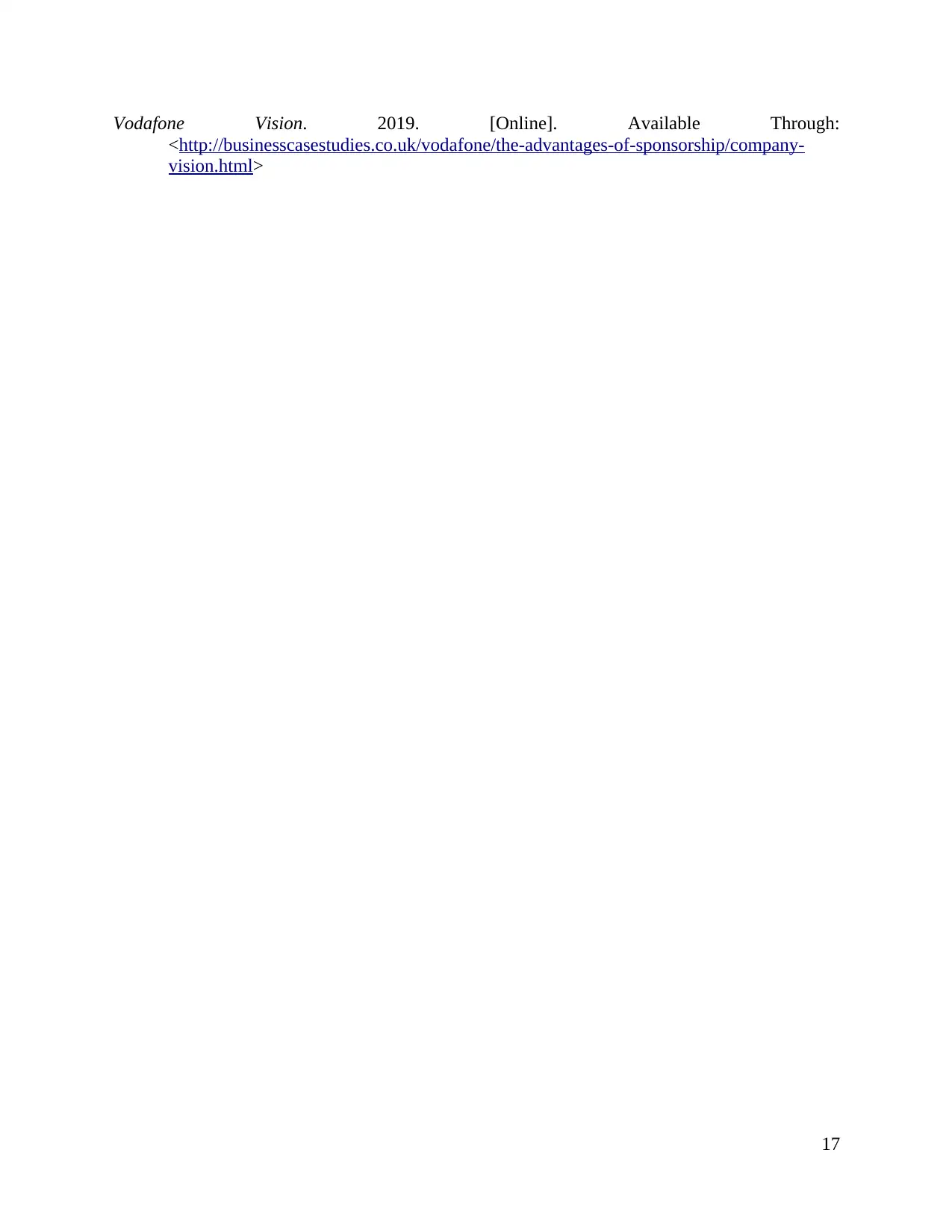
Vodafone Vision. 2019. [Online]. Available Through:
<http://businesscasestudies.co.uk/vodafone/the-advantages-of-sponsorship/company-
vision.html>
17
<http://businesscasestudies.co.uk/vodafone/the-advantages-of-sponsorship/company-
vision.html>
17
1 out of 19
Related Documents
Your All-in-One AI-Powered Toolkit for Academic Success.
+13062052269
info@desklib.com
Available 24*7 on WhatsApp / Email
![[object Object]](/_next/static/media/star-bottom.7253800d.svg)
Unlock your academic potential
© 2024 | Zucol Services PVT LTD | All rights reserved.




